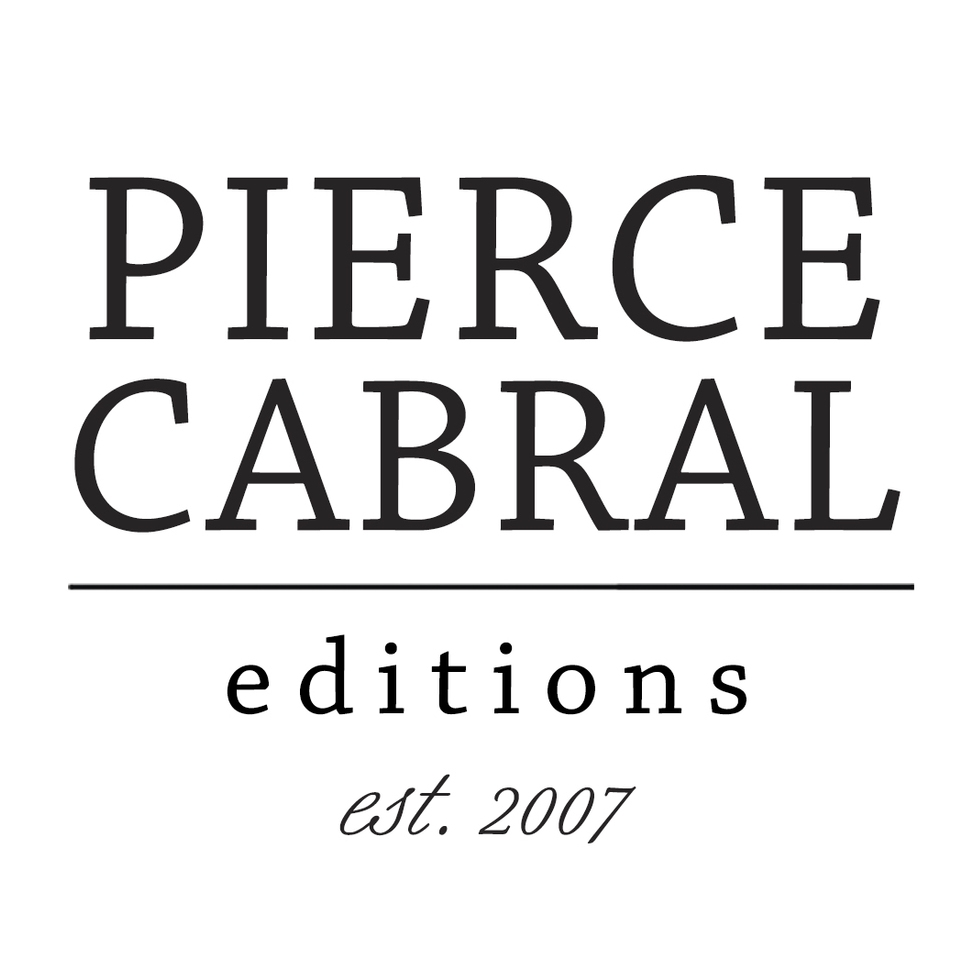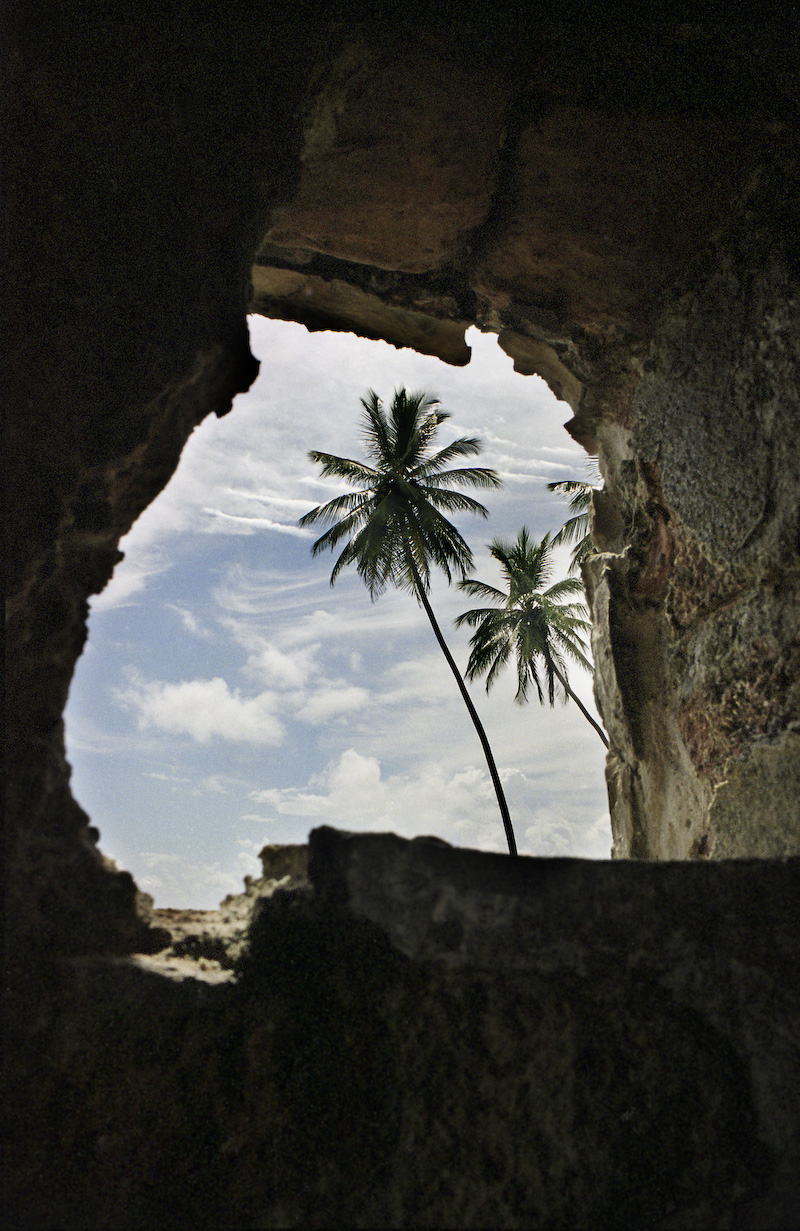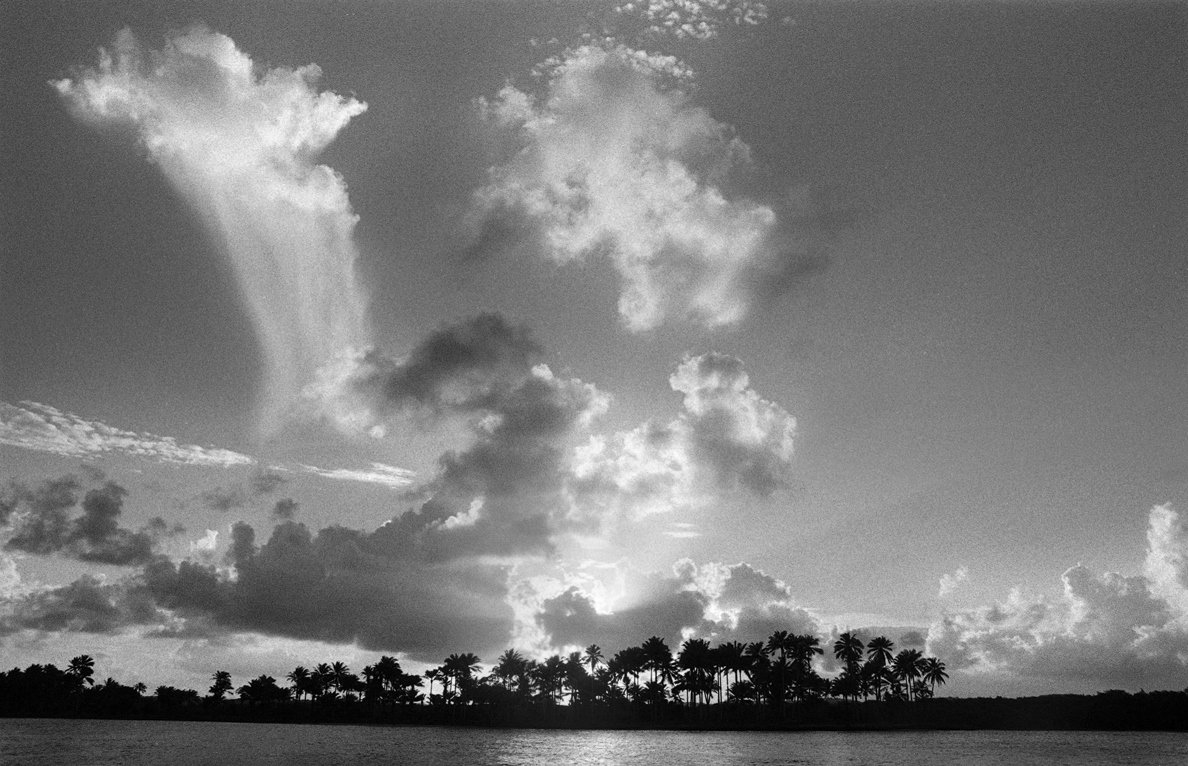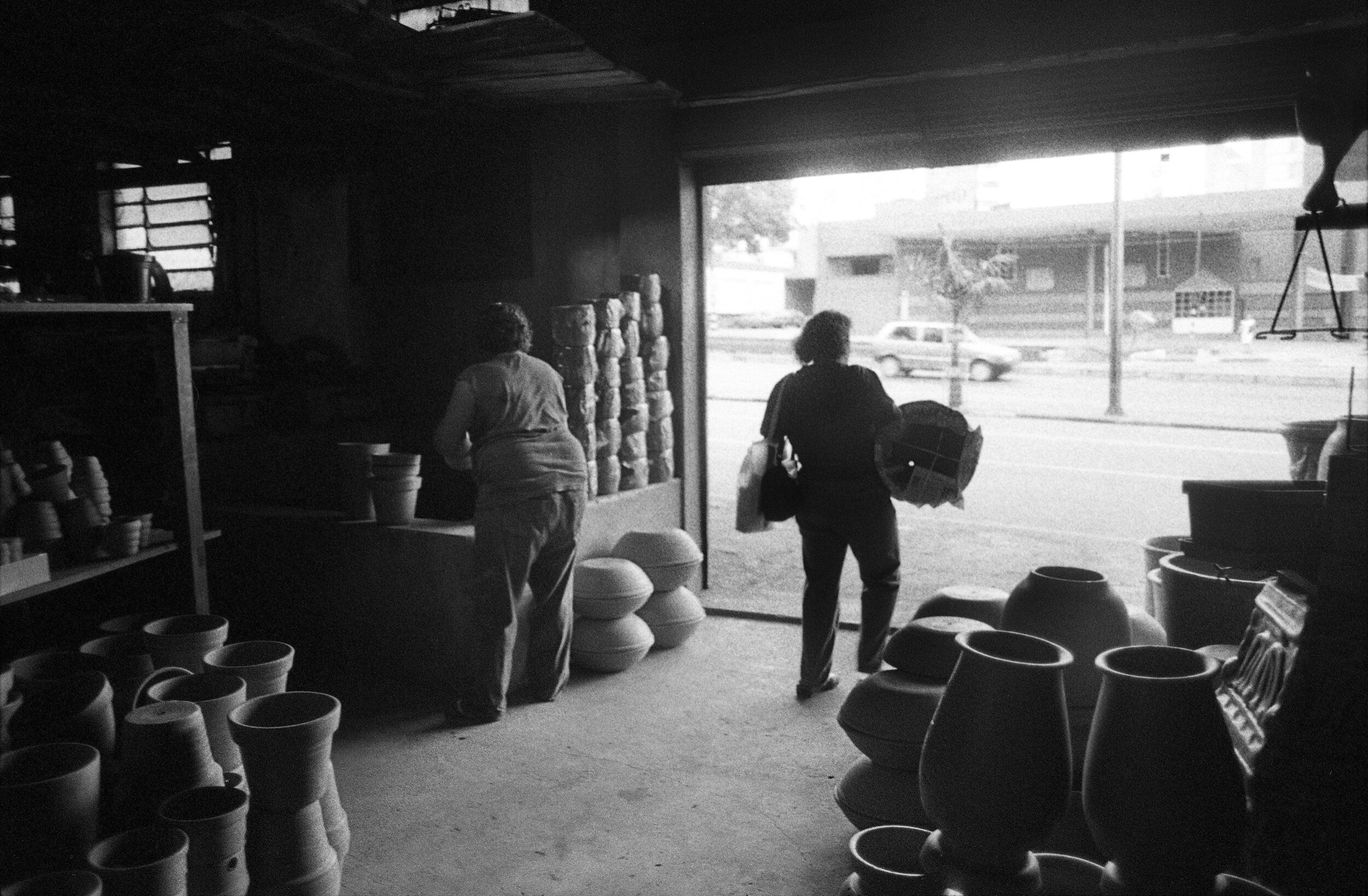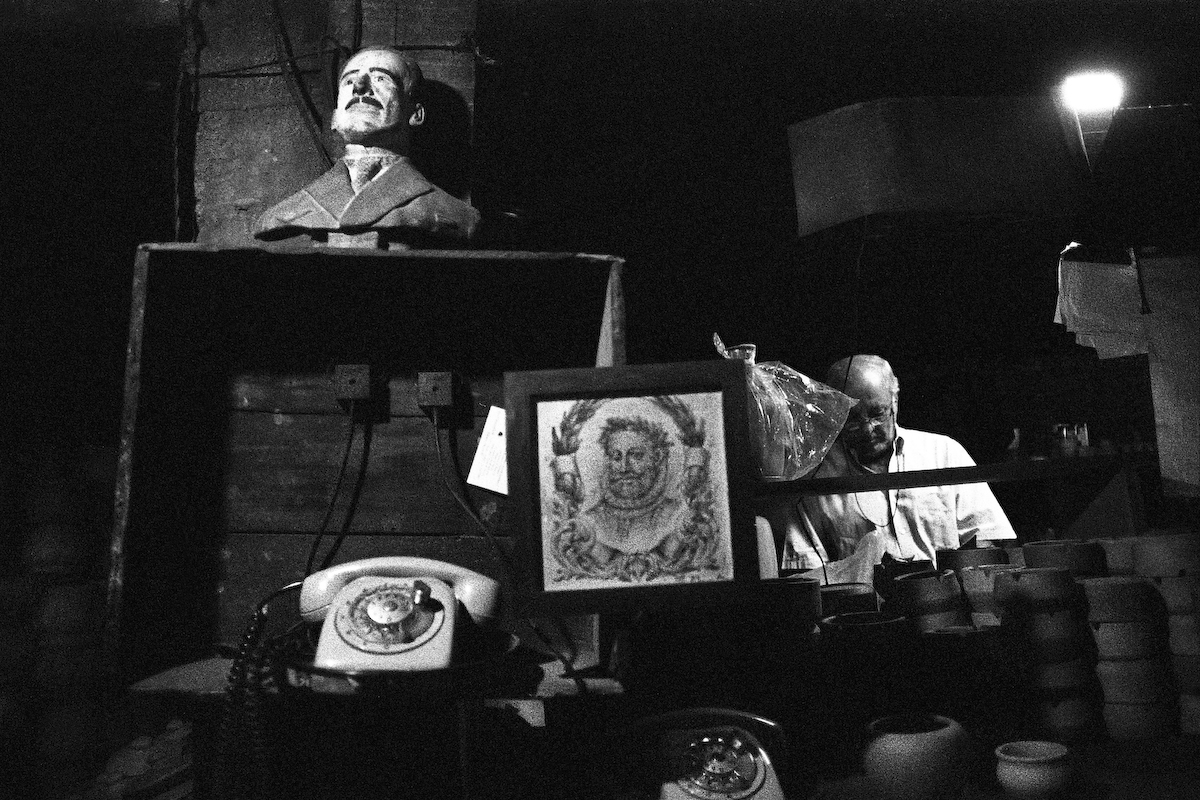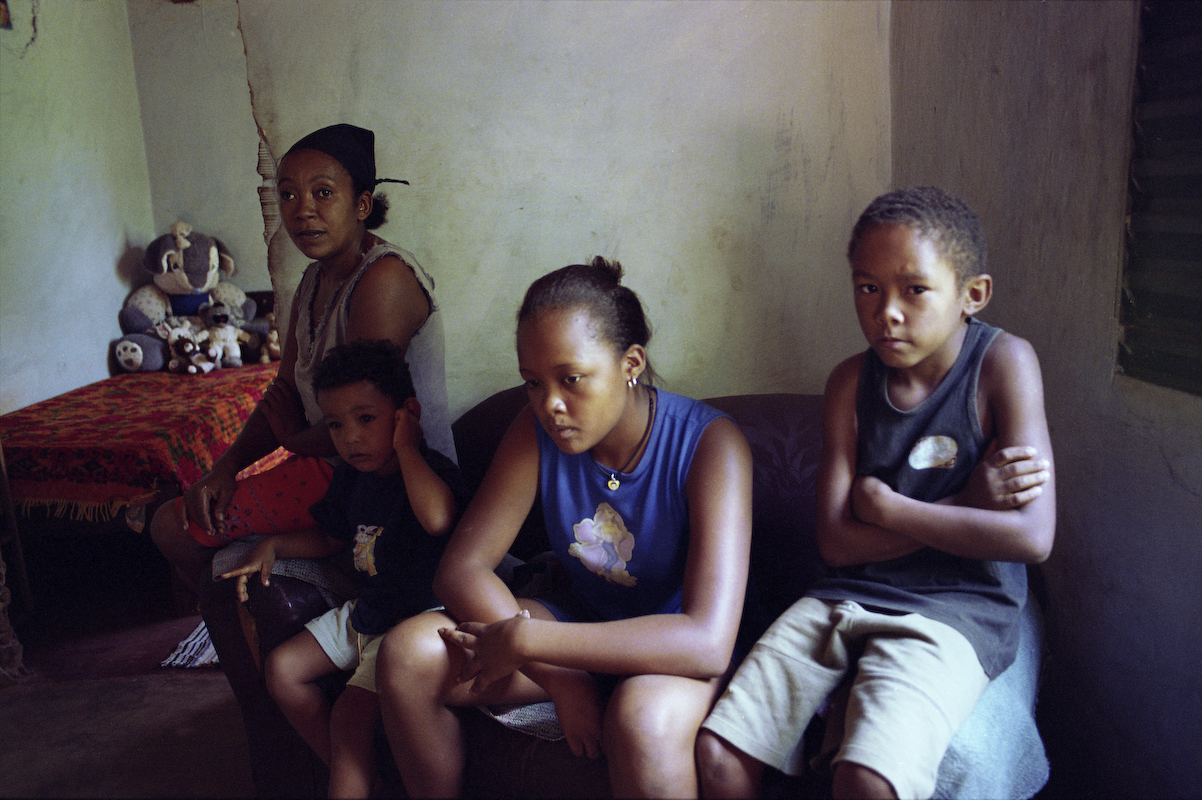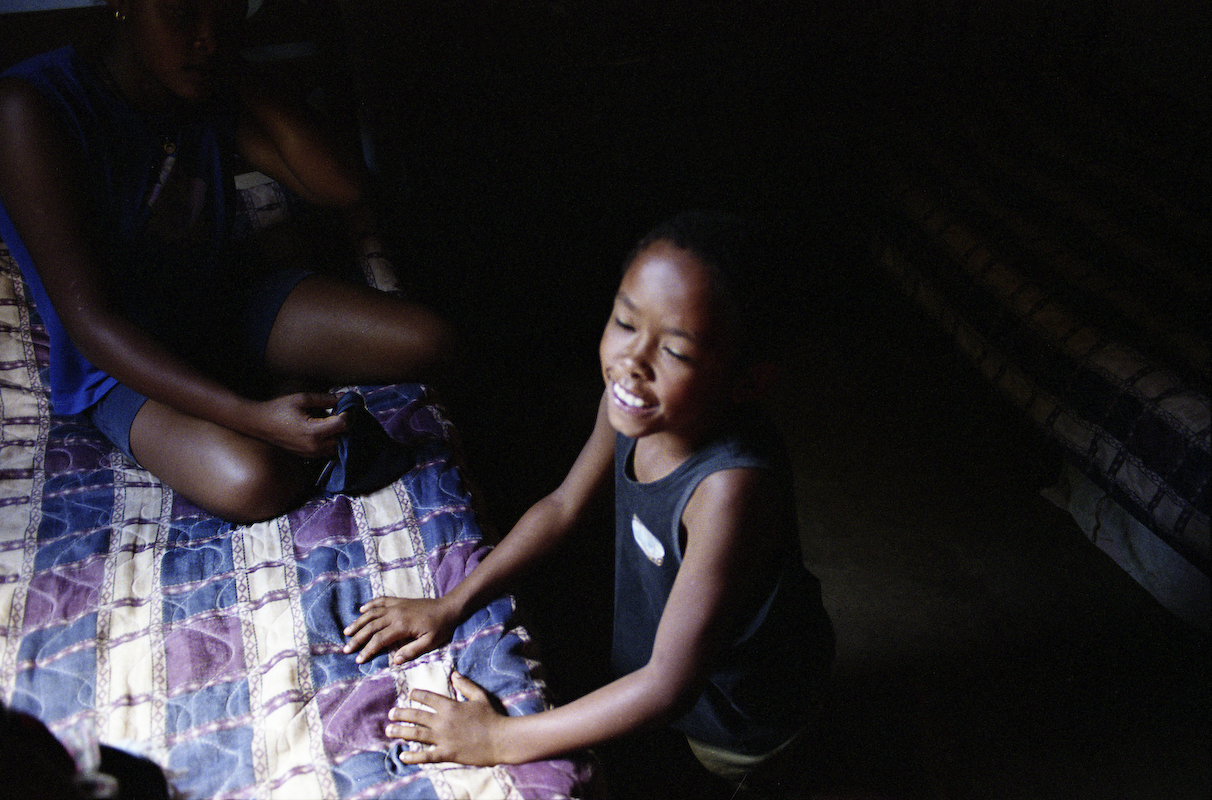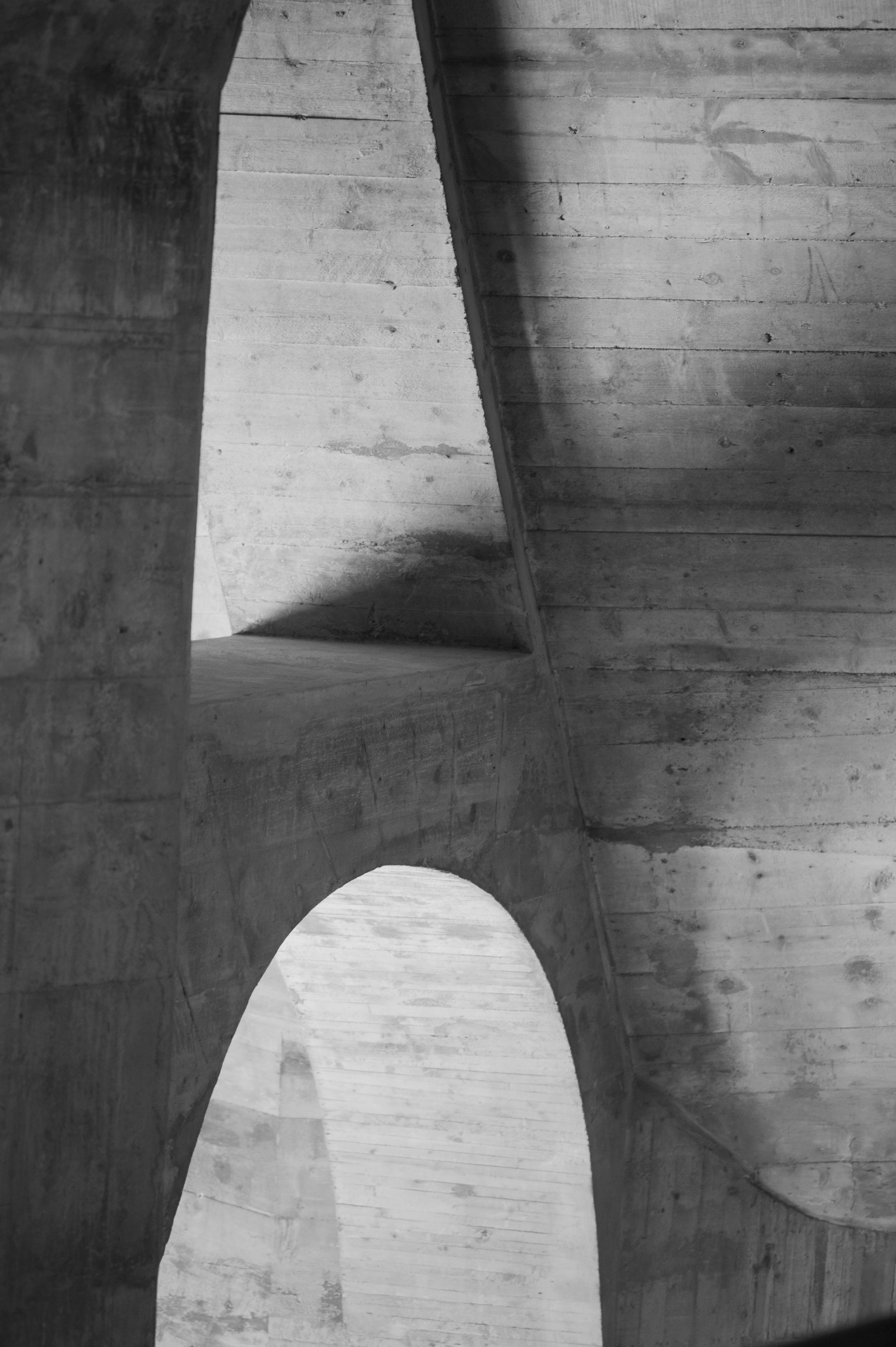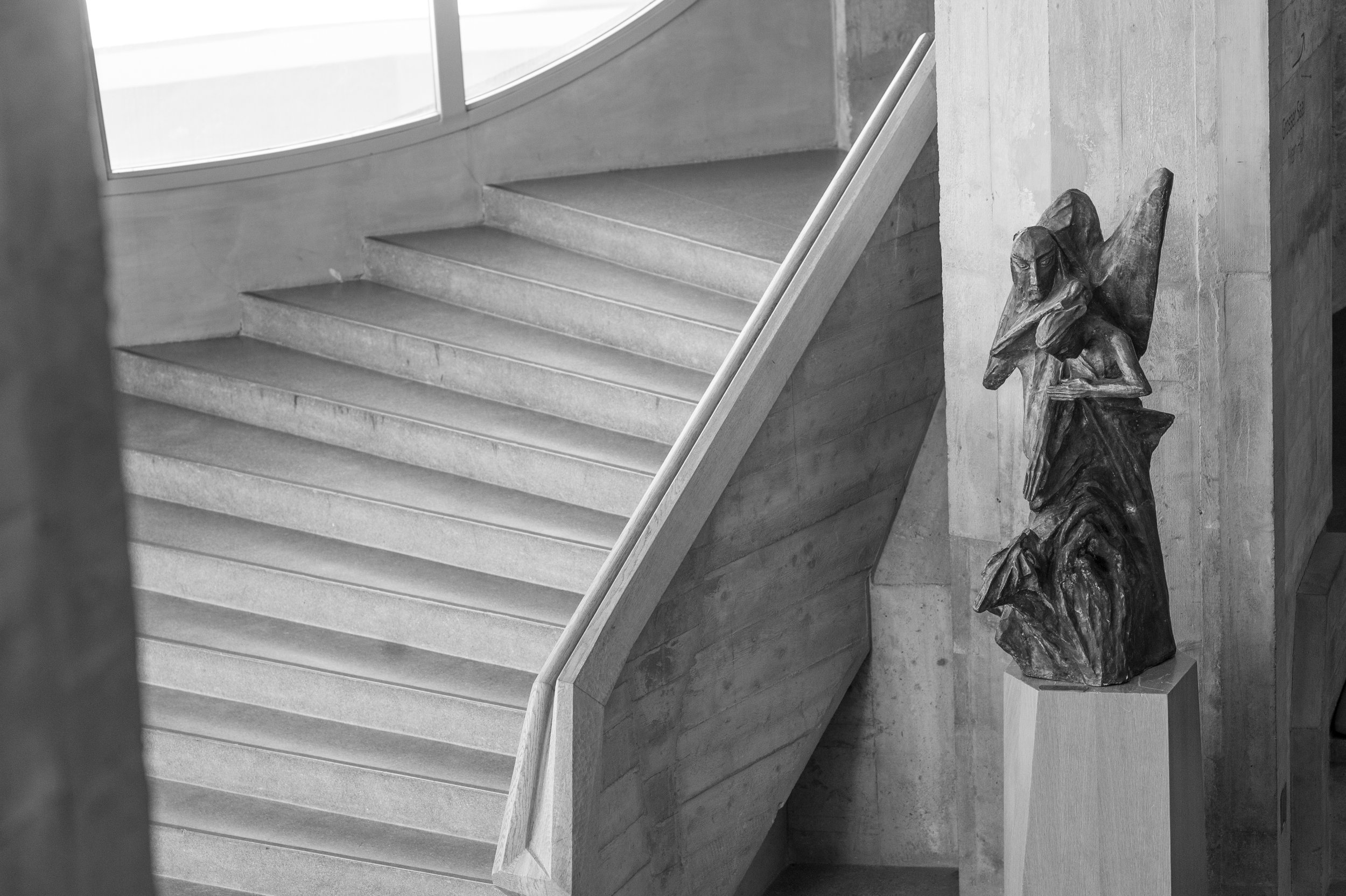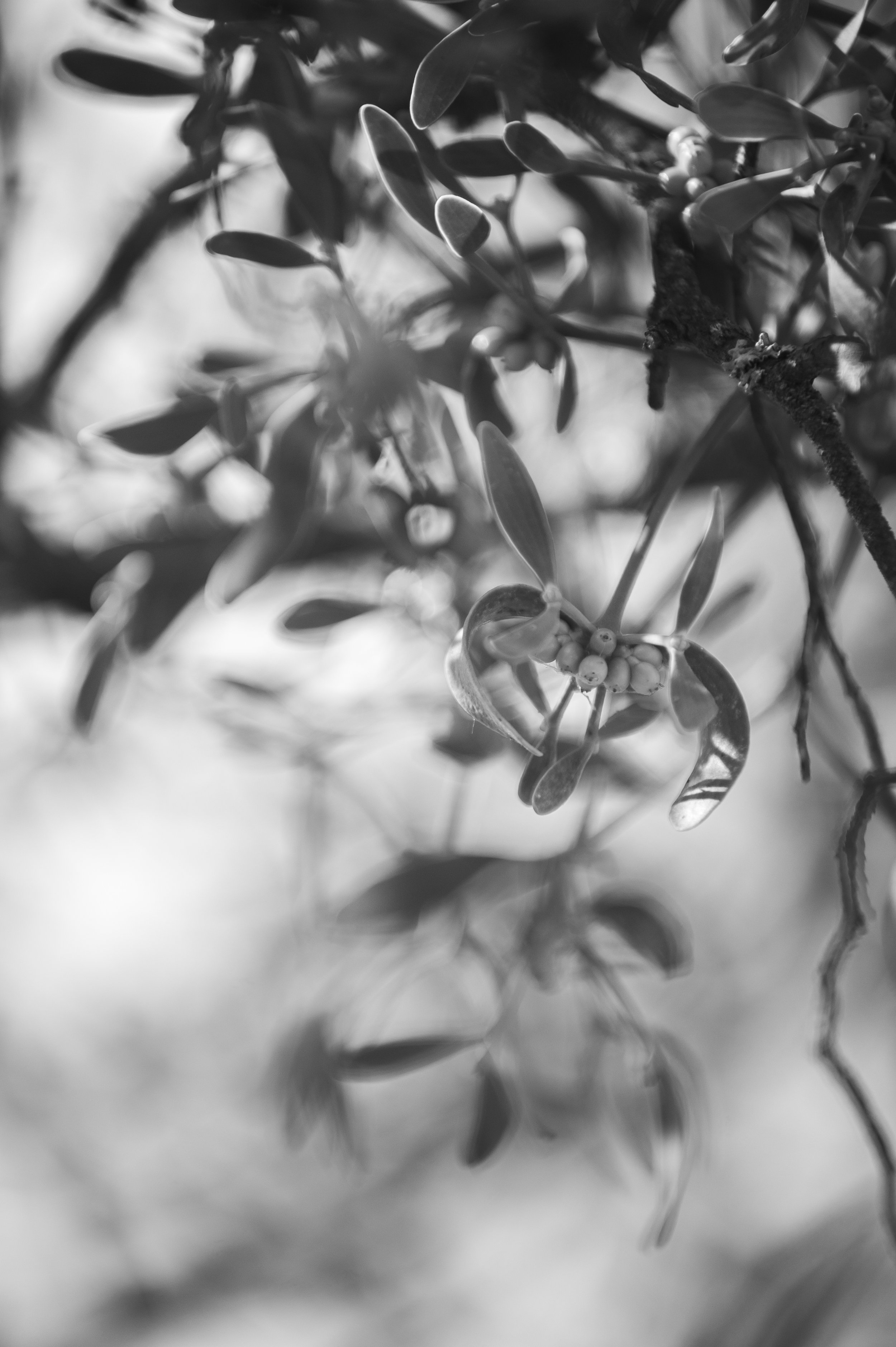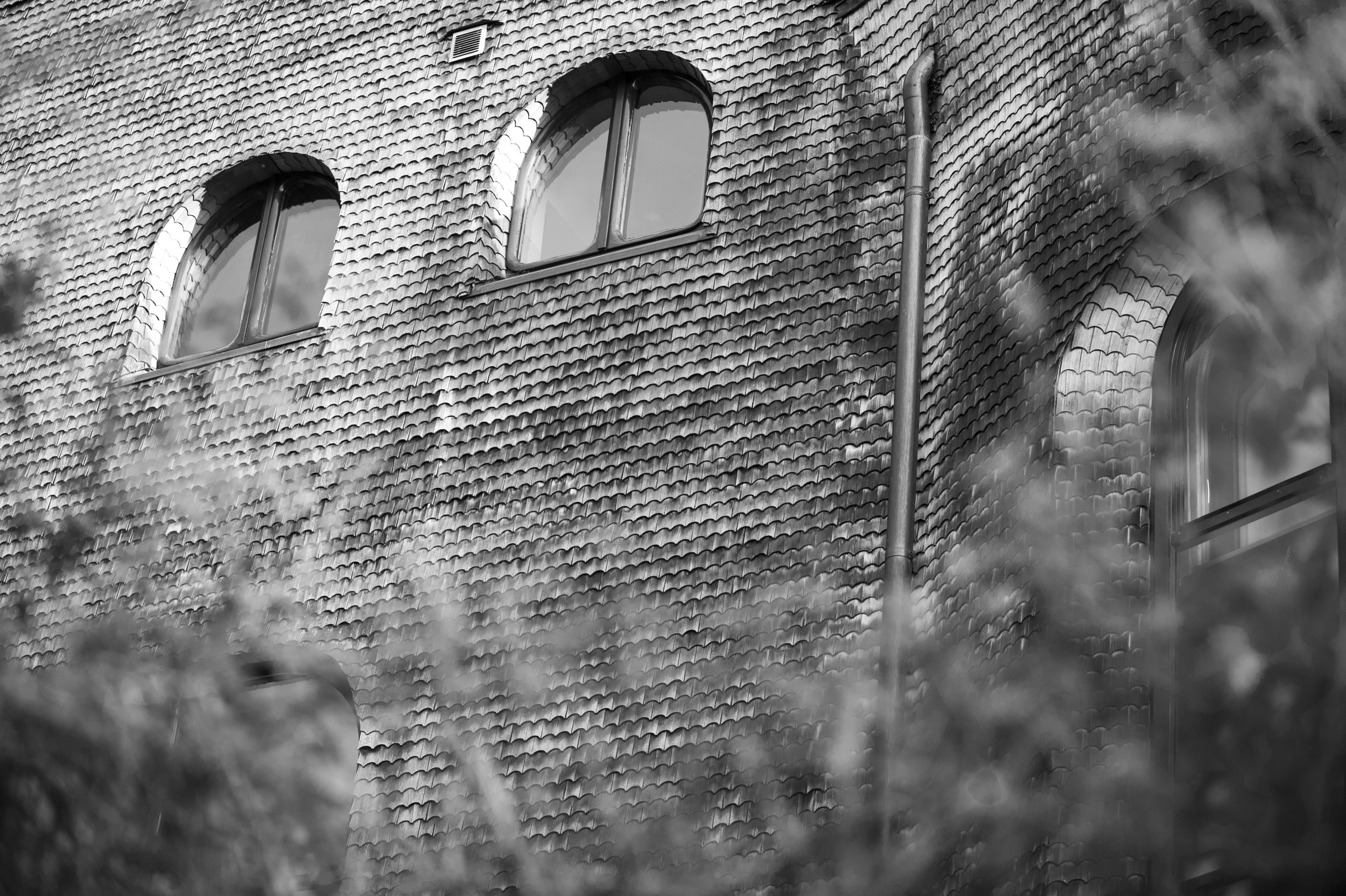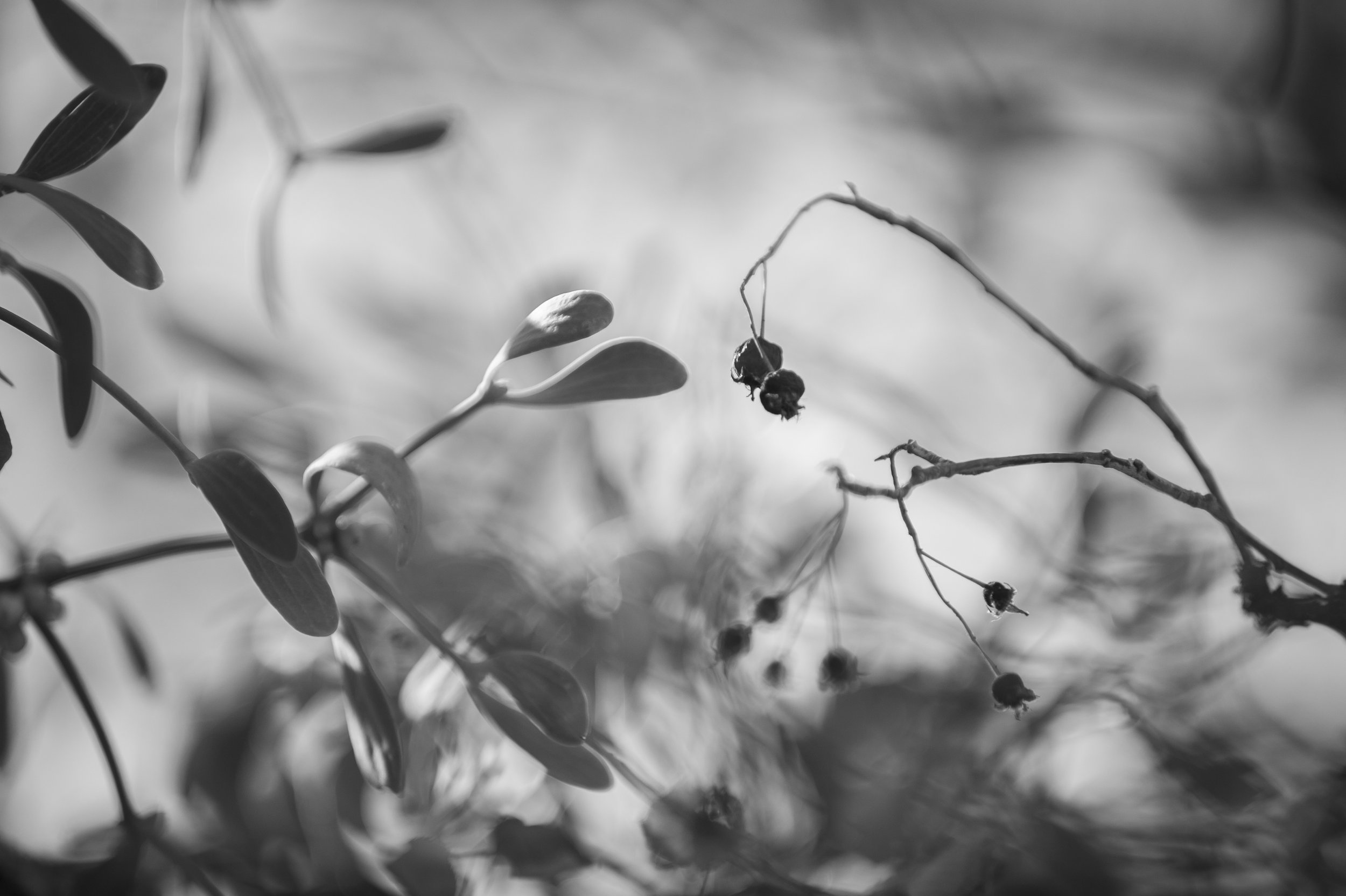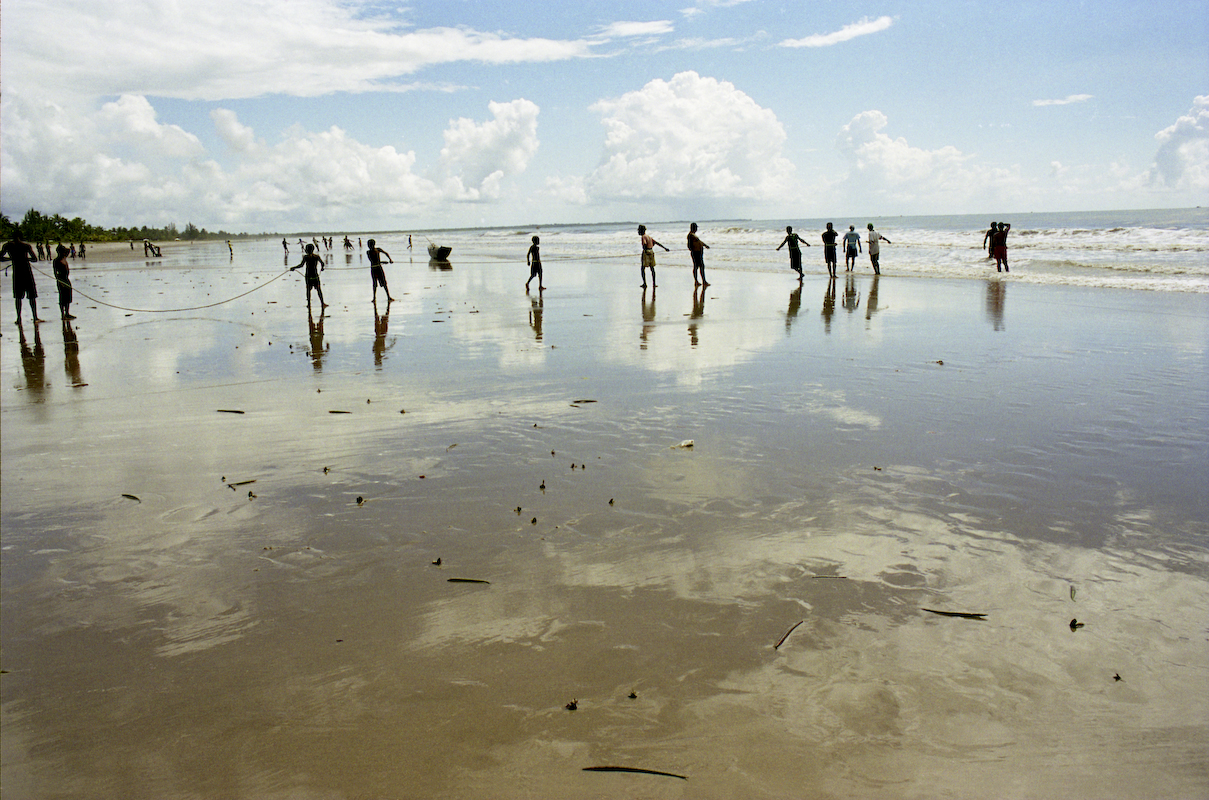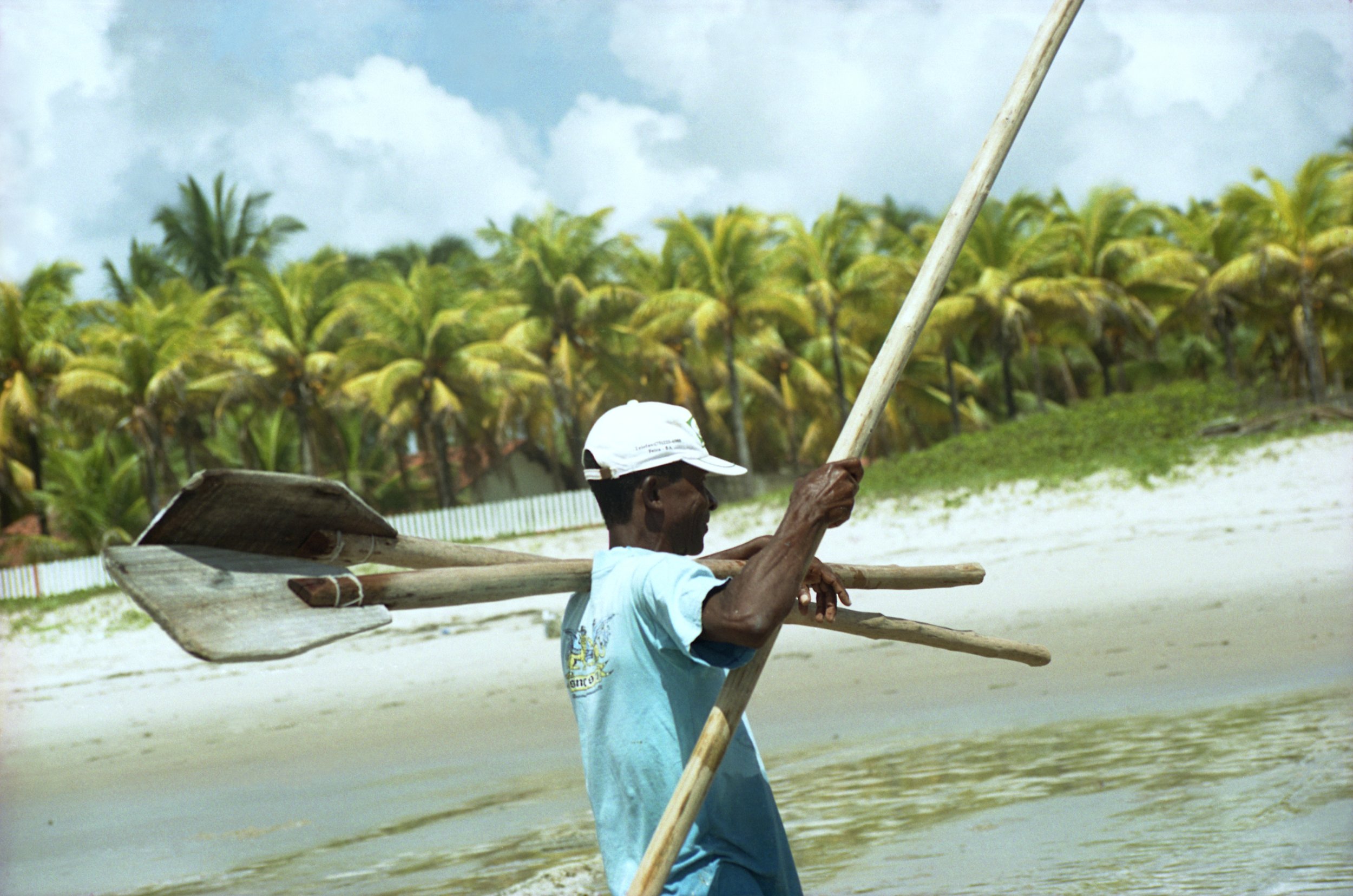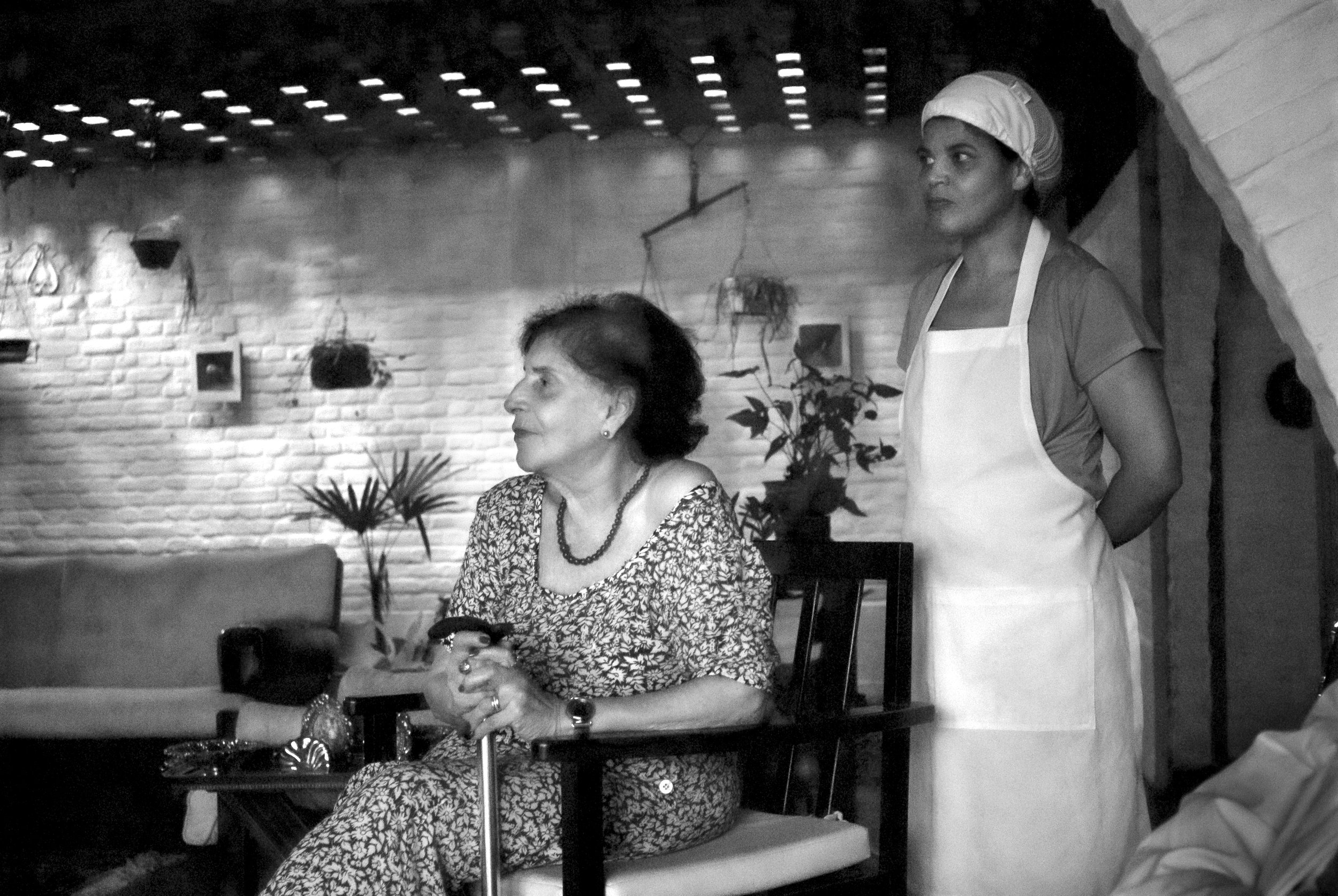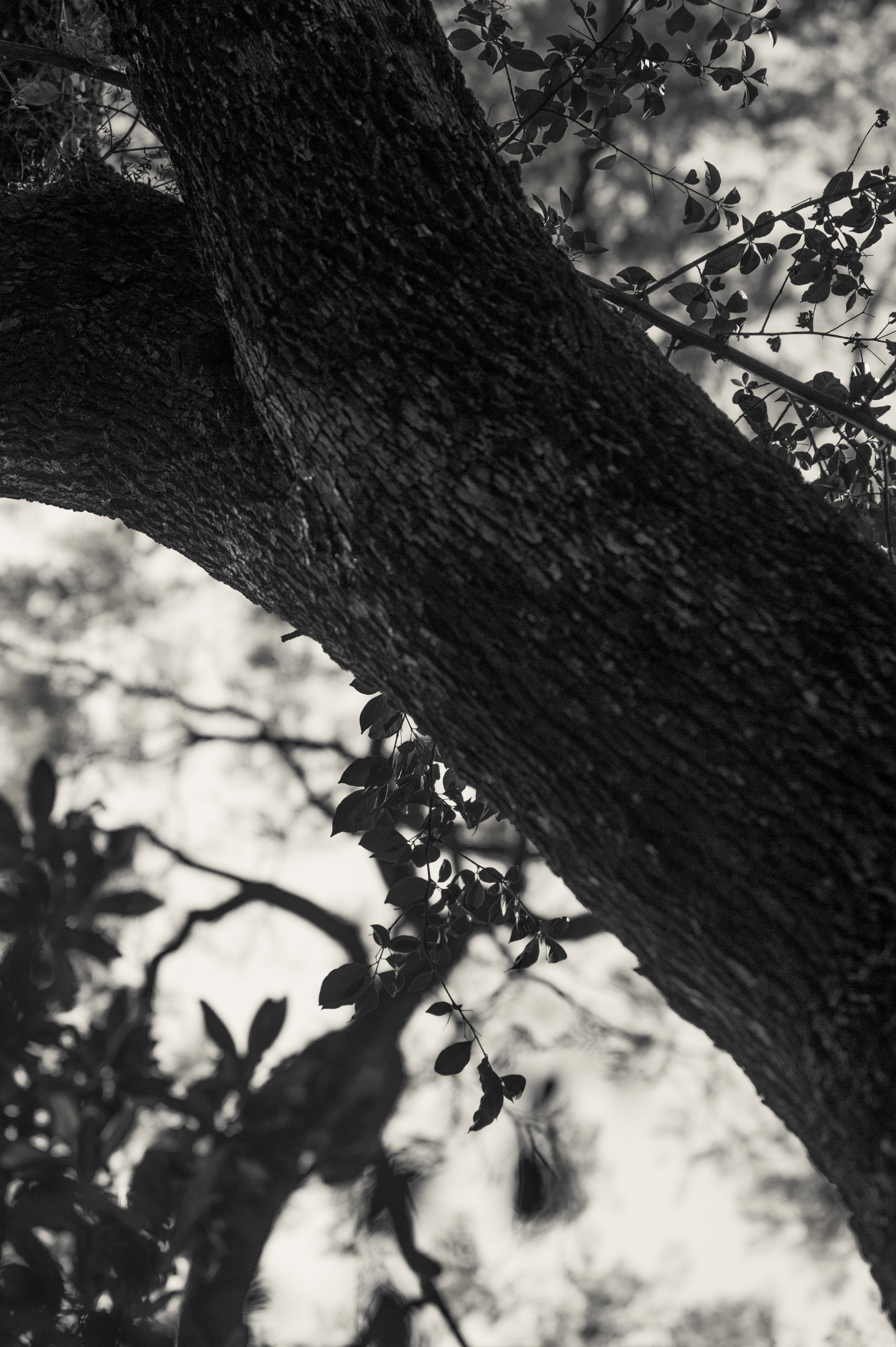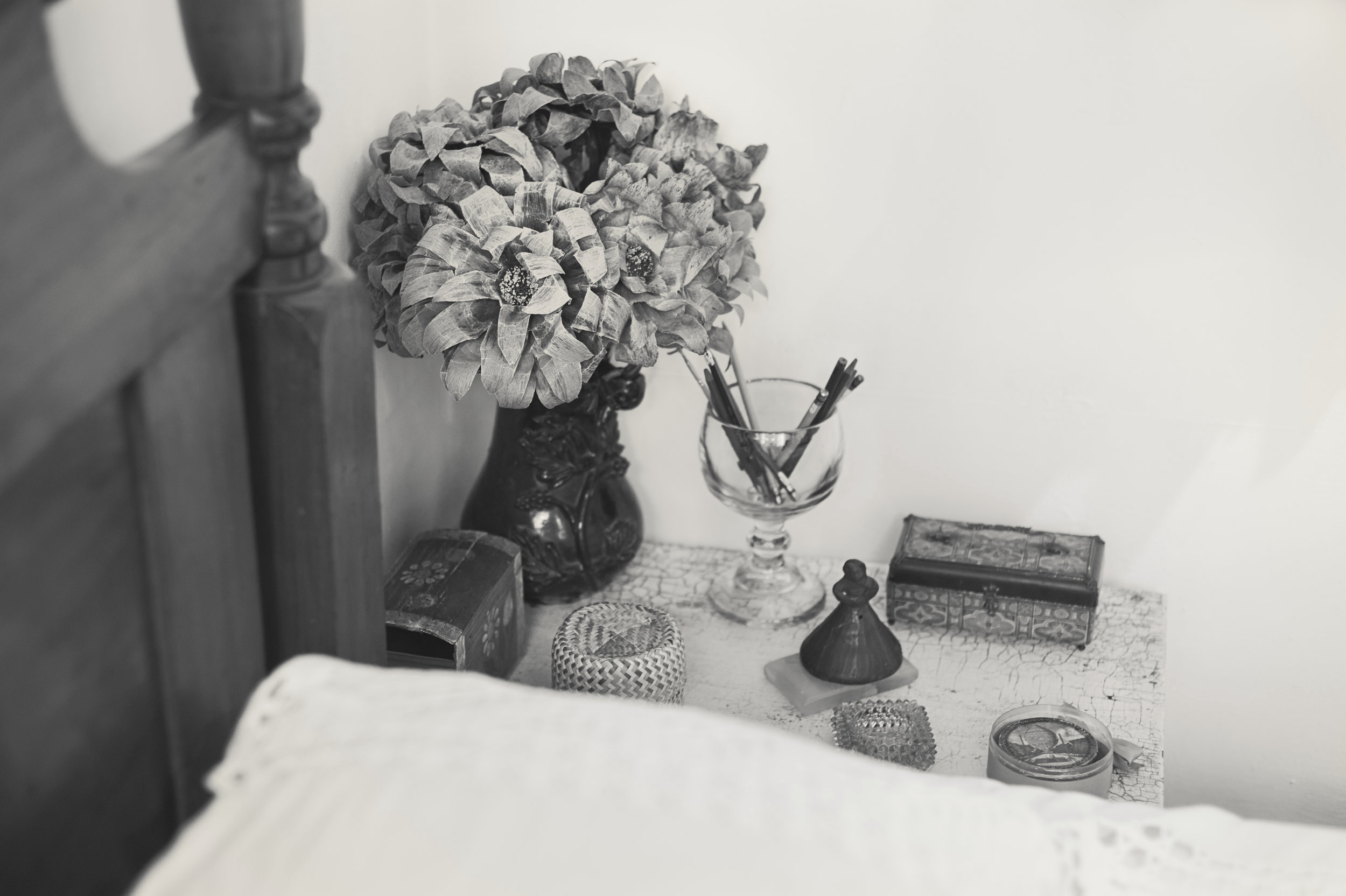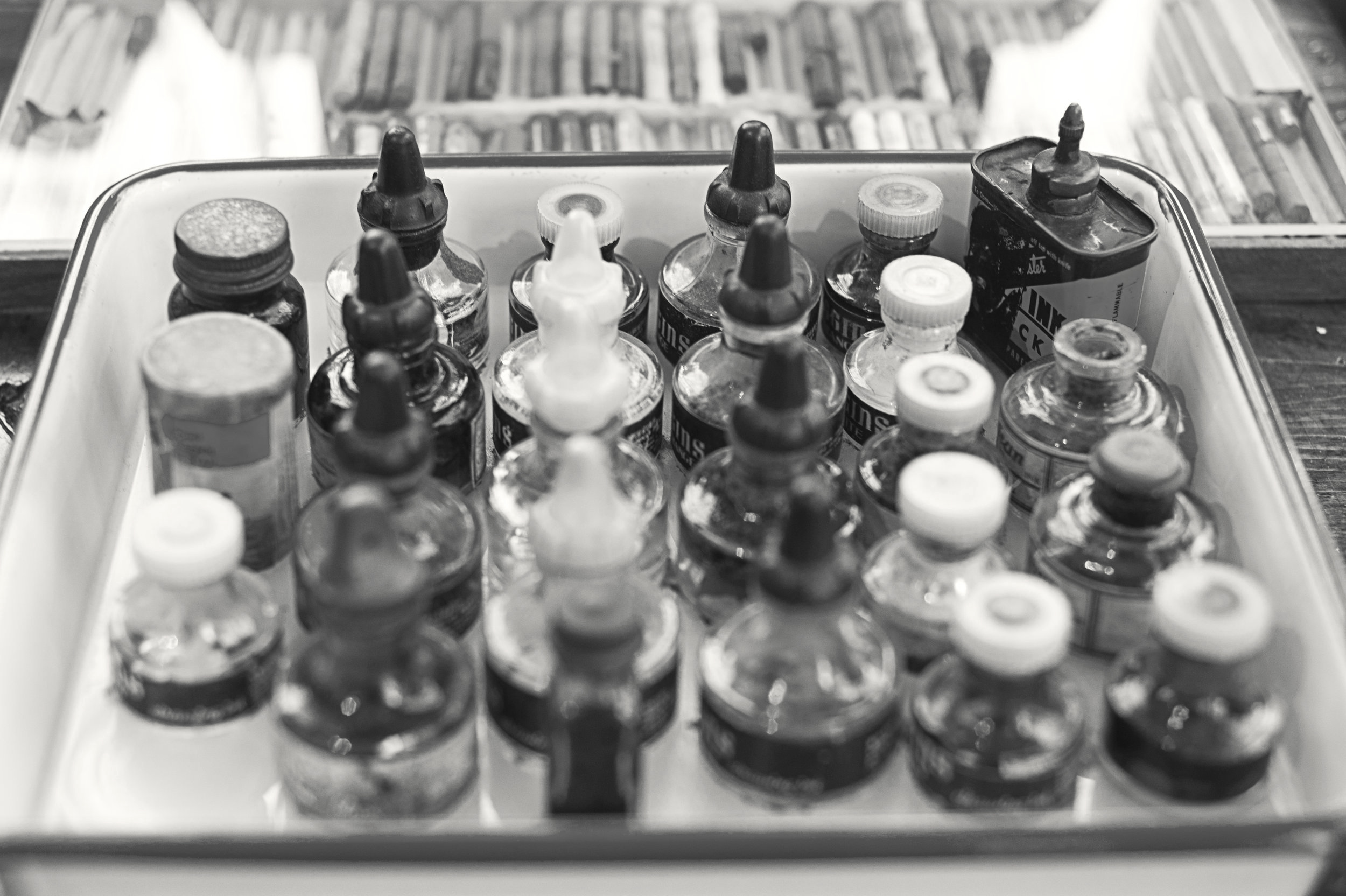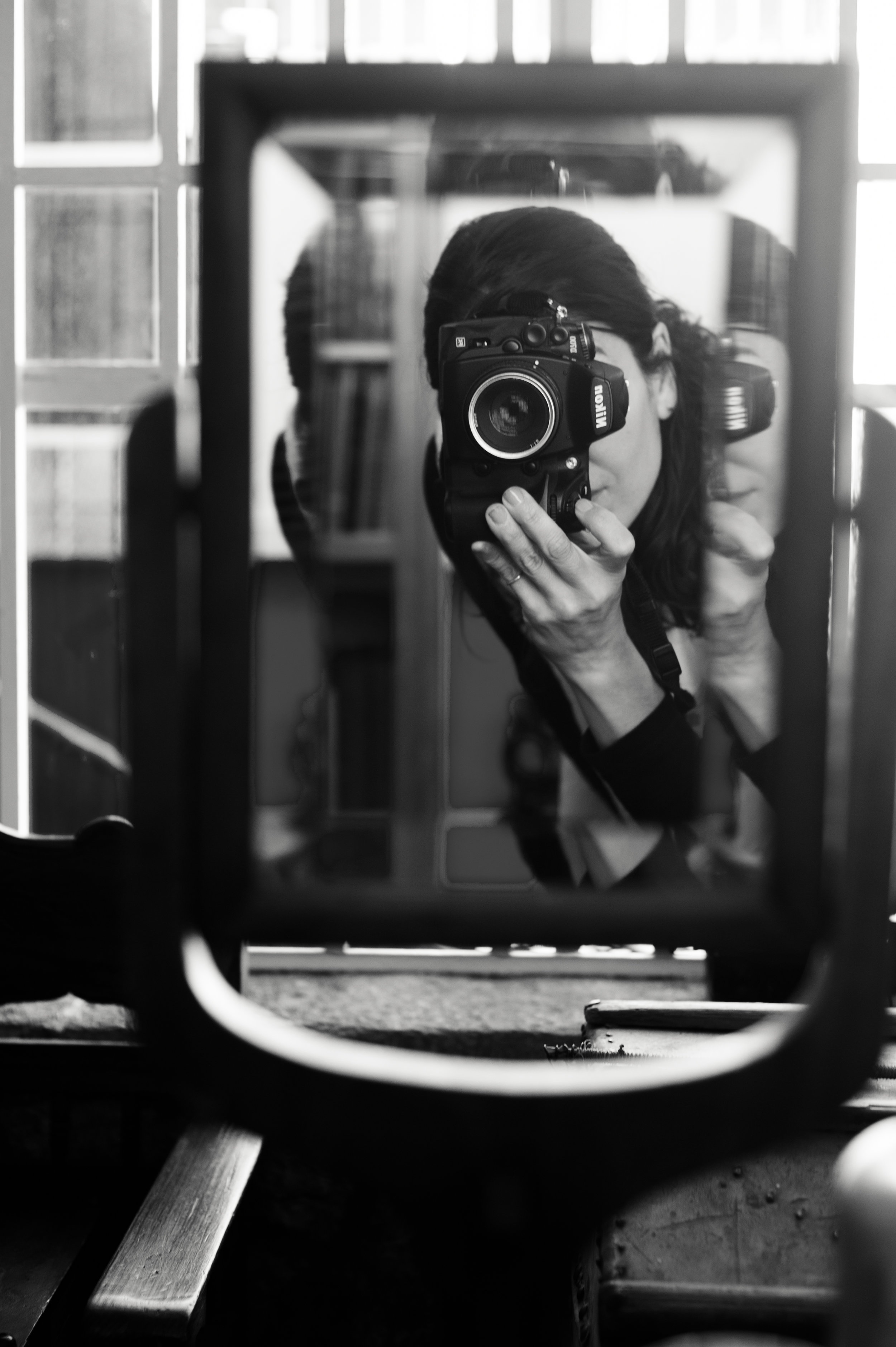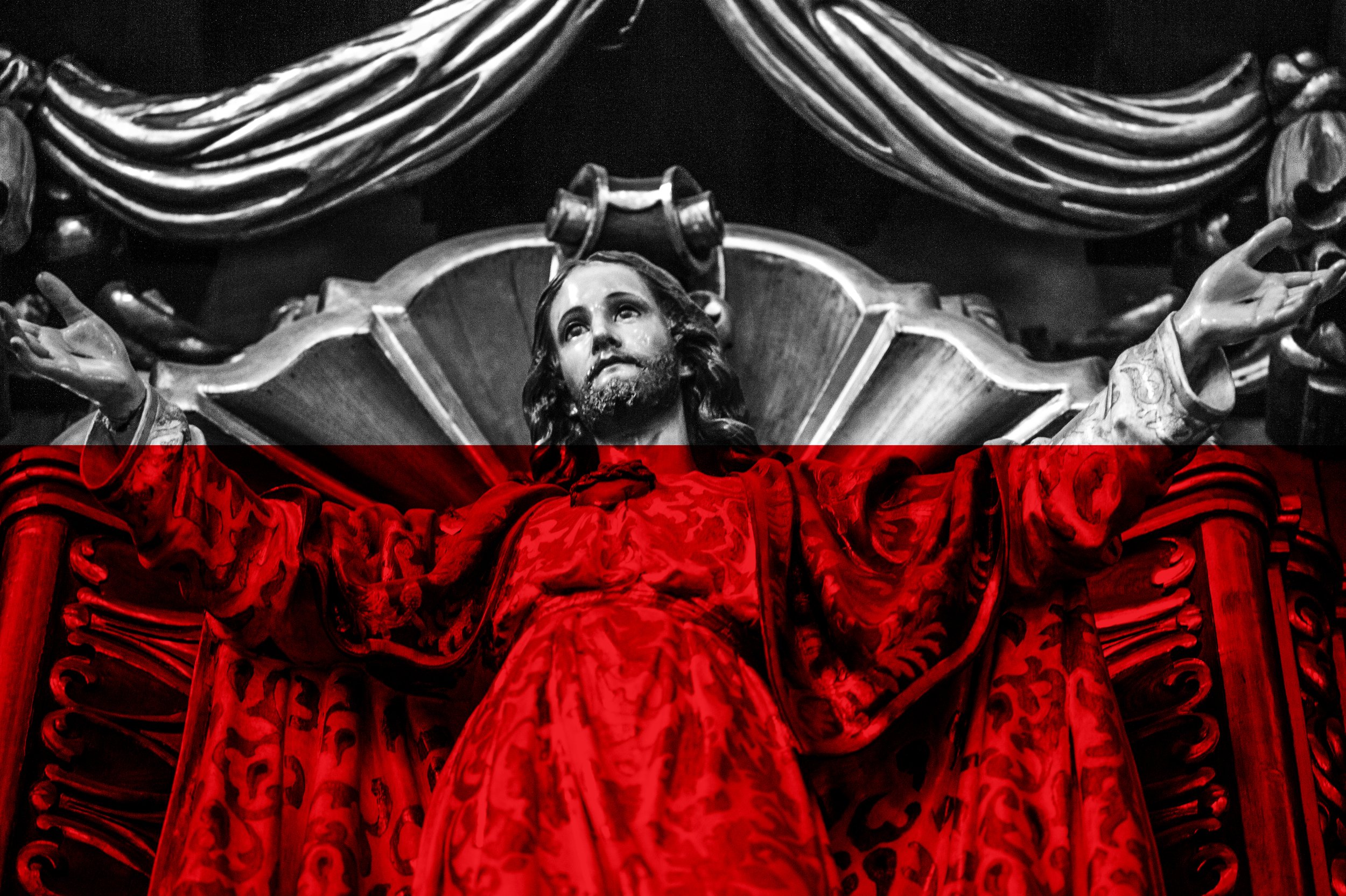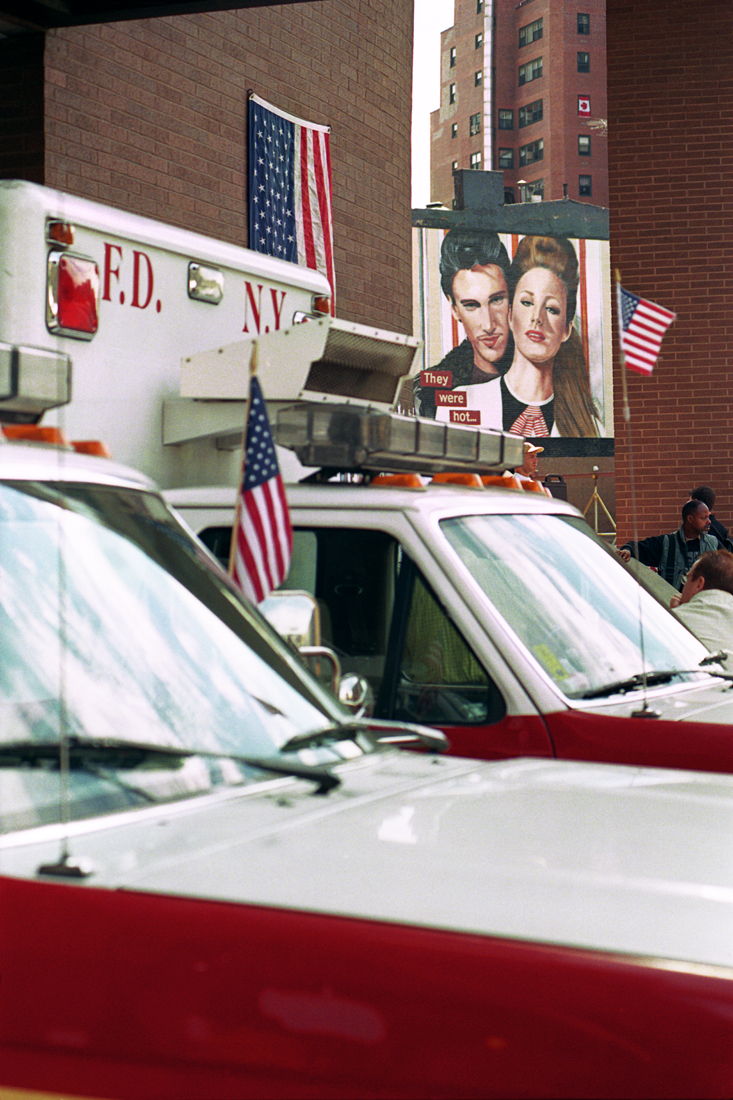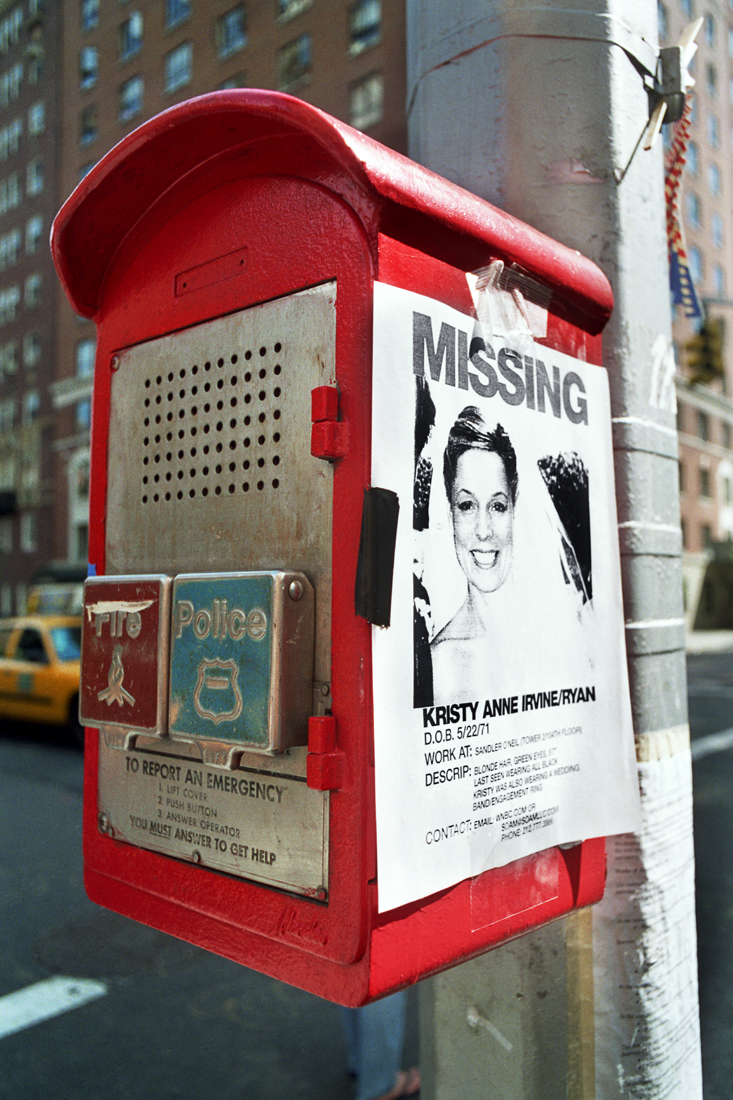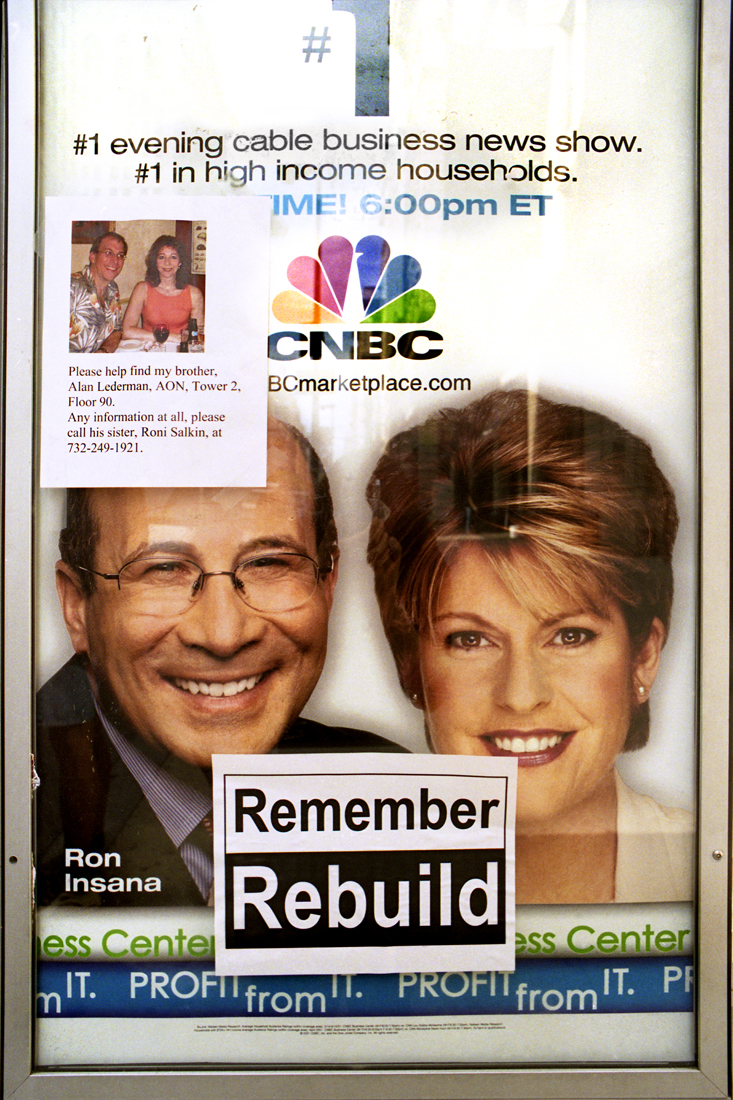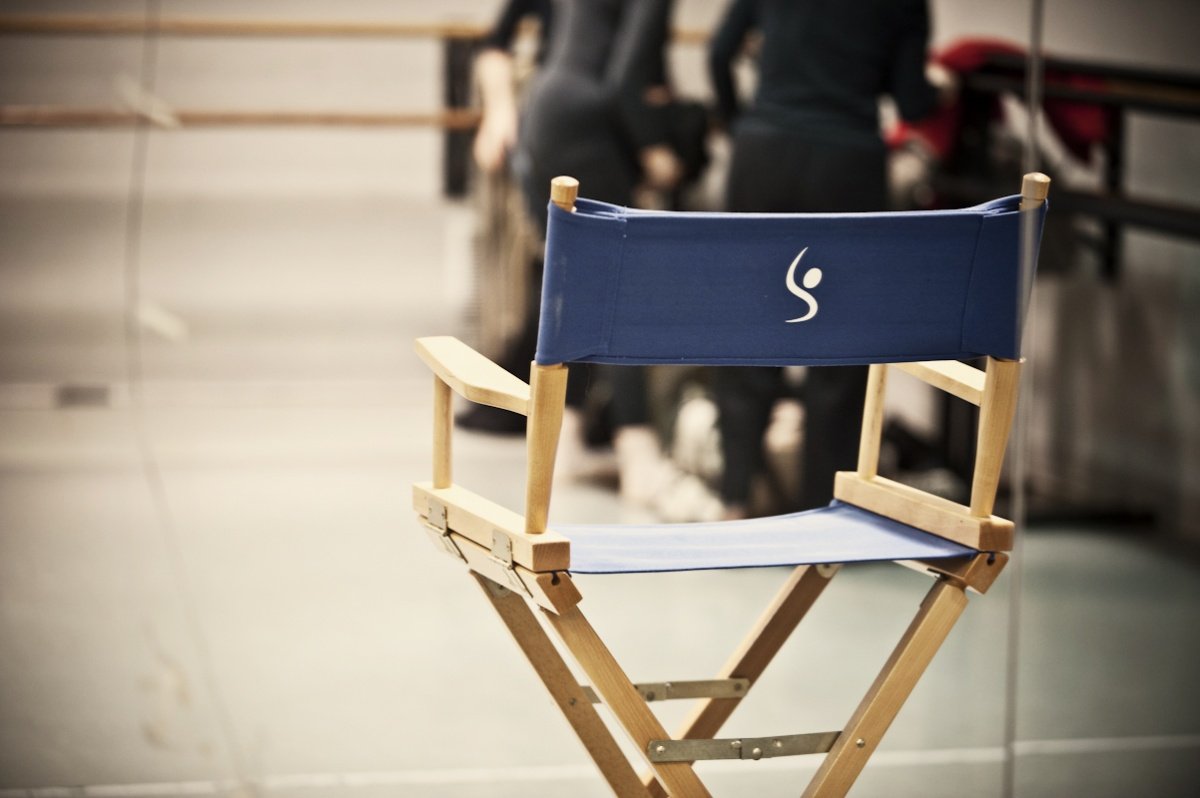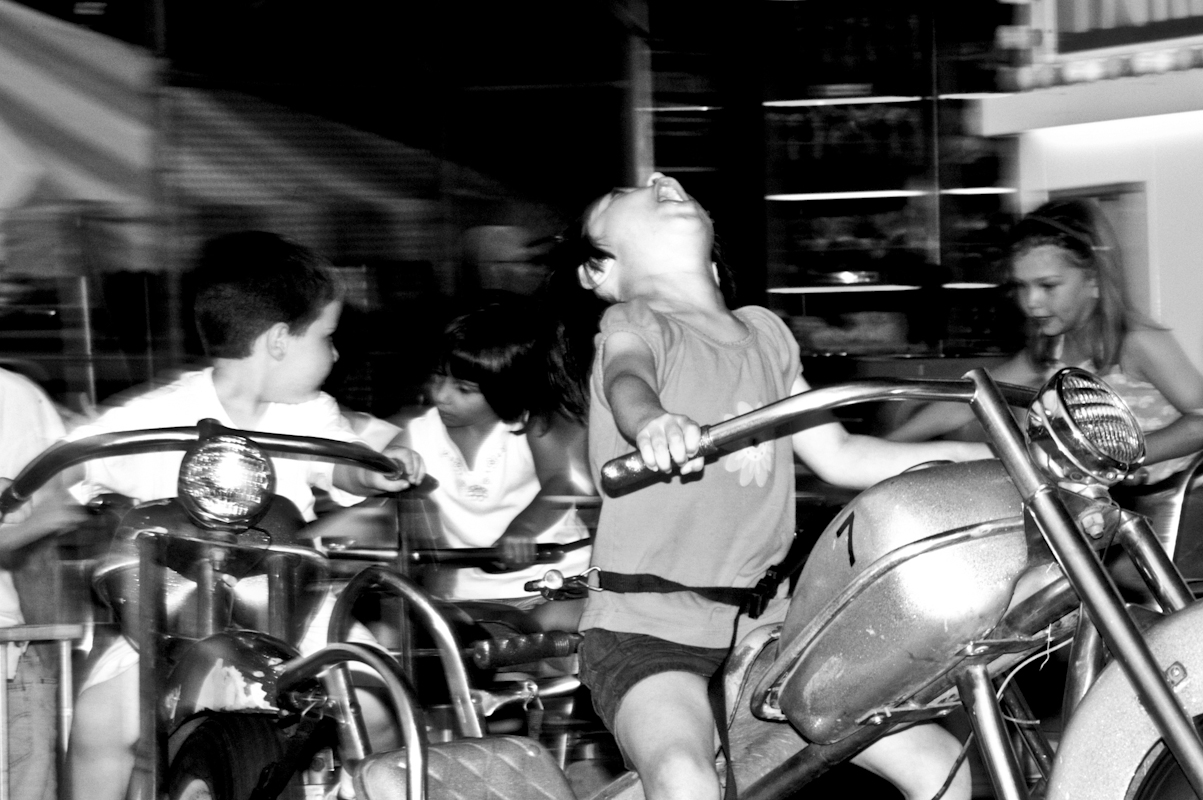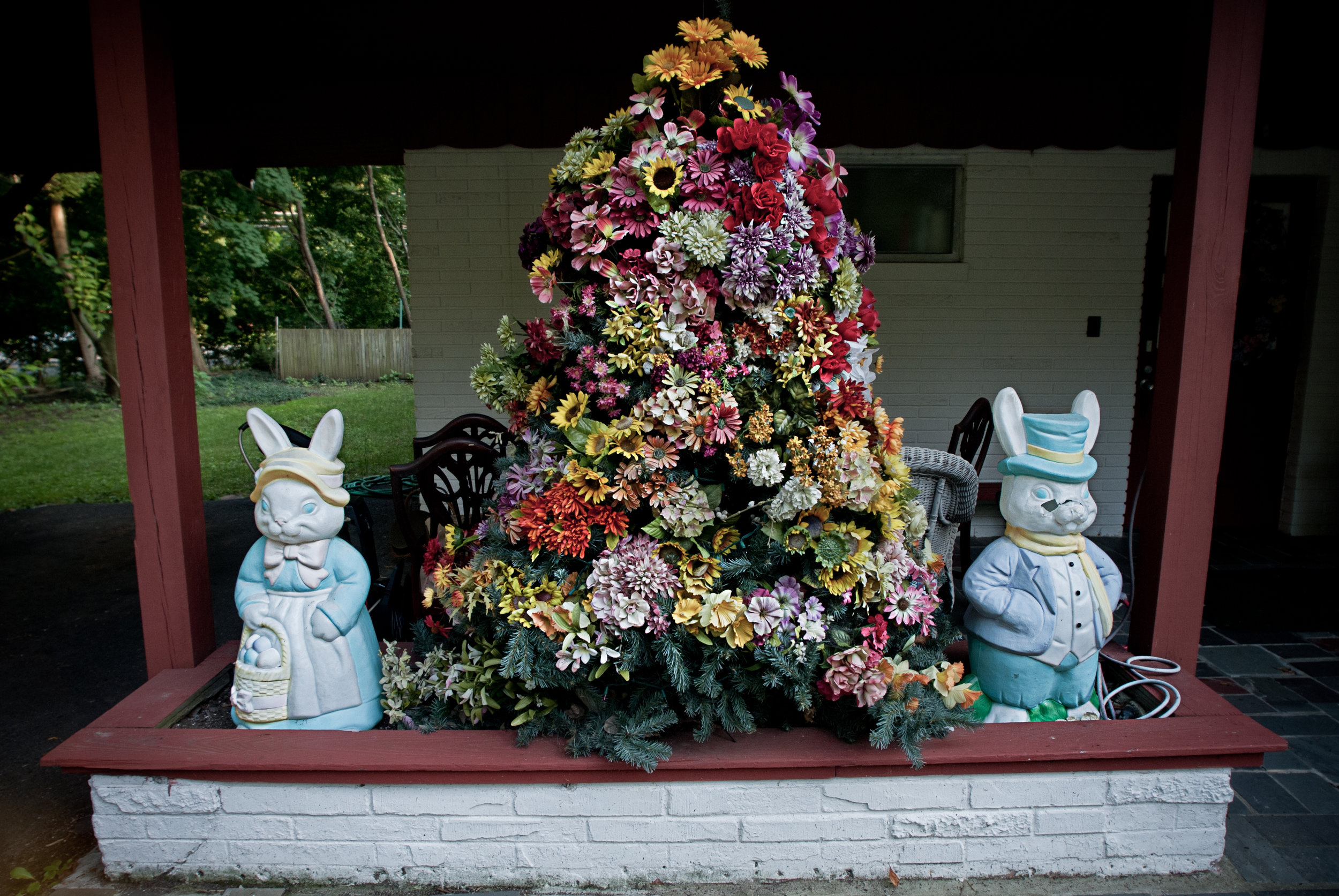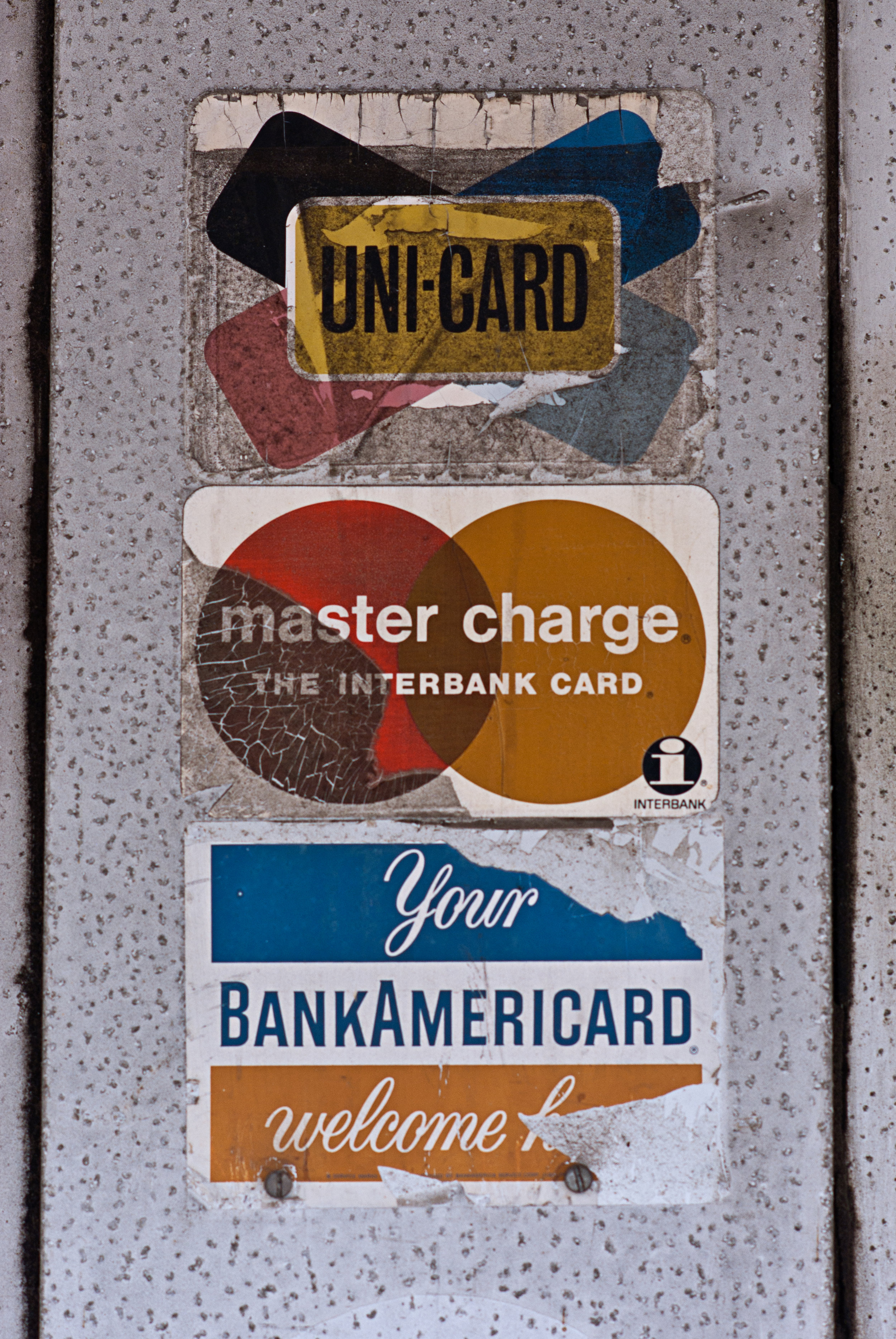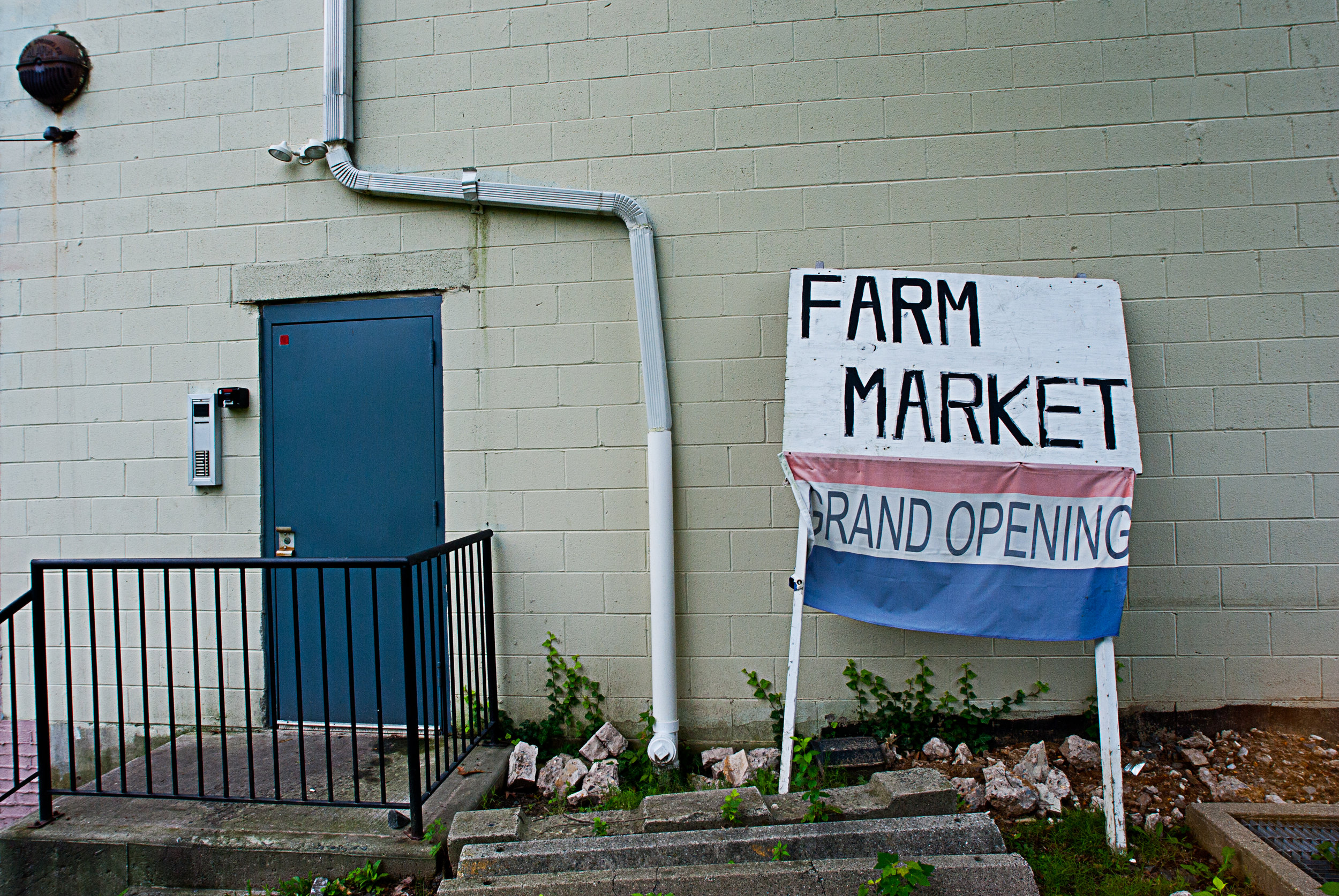M̶i̶n̶é̶RIO
The series of photographs M̶i̶n̶é̶RIO is a going back to the past. Not only as a revisiting of my own photographic archive and an excavation of images, but as an attempt to go back to a time when maybe a choice could have still been made: that of preserving a river and erasing mining off the map.
In 2009, the mining company Vale S.A. officially crossed out of it’s title the name of the river basin where its conglomerate was originated - Companhia Vale do Rio Doce. I titled this work M̶i̶n̶é̶RIO, and crossed out the word mine instead. By doing so I hope to sensitize our collective memory that behind a mine there is always a river. At least, there used to be one.
Here I present images of “Córrego do André”, one of the São João river basin tributaries. This stream, the villages and the population along the river are under an ungoing threat by the talling dam of “congo Soco” owned by Vale S.A. that is about to break and could cause flooding and contamination of all surroundings - water, earth, fauna, flora and air.
River and lives are suspended by a question: What will be crossed off the map?
If this environmental crime occurs it won’t be the first nor the last, a river basin from the state of Minas Gerais in Brazil is to be destroyed. The irresponsibility of the mining Company Vale do Rio Doce, now Vale S.A. - the largest producer of iron ore in the world - combined with government disregard and the complacency of society already eliminated from the landscape of Minas Gerais the ecosystems of the Rio Doce and Rio Paraopeba.
I bring these pictures to the surface, so we don’t become only a shadow of what we once were. a capacity not surprisingly so well performed by documentary photography. after all, shadows and its absence is all that a black and white photograph is made off.
~ To Max Henrique Barbosa
Scroll down for text version in Portuguese.
project M̶i̶n̶é̶RIO was shortlisted at Hariban Award 2019.
This year’s panel of jurors WAs made up of Annemarie Zethof & Martijn van Pieterson of IBASHO Gallery, Takayuki Ishii of Taka Ishii Gallery, Kimi Himeno of AKAAKA & Mirjam Kooiman of FOAM Museum Amsterdam.
M̶i̶n̶é̶RIO
a série de fotografias M̶i̶n̶é̶RIO é uma tentativa de voltar ao passado. Não é só um revisitar do meu arquivo fotográfico e uma escavação de imagens, mas uma tentativa de voltar no tempo quando uma escolha talvez ainda fosse possível - a de preservar o rio e riscar a mineração do mapa.
Em 2007, a mineradora Vale S.A. riscou de seu nome original a bacia do Rio Doce onde este conglomerado se iniciou. Chamava-se - COMPANHIA VALE D̶O̶ ̶R̶I̶O̶ ̶D̶O̶C̶E̶. Ao entitular este trabalho M̶I̶N̶É̶rio, e riscar as letras iniciais, Risco a mina e deixo o rio.tento assim sensibilizar a nossa memória - que por trás do minério há sempre um rio; Ou pelo menos havia.
Aqui apresento imagens do córrego do André, um dos tributários da bacia do Rio São joão. Neste momento este afluente, assim como vilarejos e a população ribeirinha, estão ameaçadas por uma das barragens da Vale S.A. - a mina de rejeitos “Gongo Soco” que ameaça inundar e contaminar toda a cercania - água, terra, fauna, flora e ar.
Rio e vidas estão em suspense. E a pergunta fica: Será que seremos riscados do mapa?
Não será a primeira vez, e provavelmente nem a última, que uma bacia hidrográfica no Estado de Minas Gerais é ameaçada de destruição. A irresponsabilidade de Mineradoras como a Vale S.A.- A maior produtora de minério de ferro mundial - combinada com o desleixo governamental e a complacência social, já eliminaram da paisagem de Minas ecosistemas como os do Rio Doce e do rio paraopeba.
Trago estes retratos à tona, para que não restem apenas sombras daquilo que um dia fomos.
nada mais natural do que usar a fotografia documental, já que é da ausência e presença de sombras que a fotografia em preto e branco, pura e simplesmente é feita.
~ Para Max Henrique Barbosa
Extractivists
From the coast of Bahia, it takes 40 minutes to reach the farm of Julio Mello in Northeastern Brazil. I ride on the back of a truck. The hot sun releases the scent of fruits growing in the region. I can smell and almost taste caja fruit, cupuaçu and acerola in the air as I cross the Brazilian Atlantic Forest. Of the Tropical Forests, it's the most generous in biodiversity. In the state of Bahia, 270 species were cataloged in a mere hectare. Even though this ecosystem is protected by Brazilian environmental laws, only 7% of the original forest is left. The forest remains for the population that doesn't migrate looking for labor in the urban agglomerations scattered in the Atlantic coast. At least patches of it. They could easily live off the forest's abundant fauna and flora but instead, they have to offer their labor in exchange for a salary and a place to live with their families. Most Brazilians have no land to call their own.
Land ownership is the privilege of a few – two-thirds of all arable land is concentrated in the hands of only 3% of the population. No wonder the Landless Workers' Movement (MST) originated in this nation. Since the 1980's MST remains as the prime advocate for land reform. It uses the invasion of large unproductive land as its main tactic to vindicate the landless. It is estimated that 166.000 families are living in squatter camps on invaded properties in Brazil.
Outside a typical mud house from this region built with straws, twigs and branches, a 2-year-old is sucking on a mango. A woman holds a broom made of dried leaves. She is meticulous as she swipes the dirt floor underneath her bare feet. She greets me with a smile and invites me to come closer. She walks out of the house with a bundle in her arms and proudly introduces her 2-days-old daughter, Joseane. The baby's father had already left to work, he will spend his day of labor working on someone else's land. At least he found a conscious landowner to work for. At the farm owned by Julio Mello, this family will sustainably collect the riches of the forest, respecting the rate of regeneration each species needs to allow the survival and growth of the Atlantic Forest. In return, the forest shows its generosity by giving abundant cocoa, caja fruit, guarana, cupuaçu, cashew, Palm of oil fruit and acerola. It is as if the forest knows not many landowners are of this kind.
For Mr. Mello exploiting the land means preserving it. He mostly collects what the forest offers. When clearing for a crop is necessary he makes sure to keep as much as possible of the original vegetation in some other area of his property. He takes me to one of the areas of Atlantic Forest he preserves. It is intact. As I step into the forest I am engulfed by the thick humid air. The sun cannot accompany us as we penetrate the vegetation, but its heat can. We haven't even walked for 20 minutes and I'm covered in sweat. The vegetation is luxurious: exotic flowers, gigantic leaves, and contorted trunks. From inside the shaded forest, Mr. Mello asks me to turn around as he points to his neighbor's property. No trees are left, only cattle herds that look like small dots on a map. The land looks naked under the thin grassed fields. The landscape is now too vast. Everything will seem small after I've been inside the forest.
A school bus passes in front of the farm's gates. Hamilton, a handy boy in the property, is burning firewood to slowly roast cashew nuts.
Like his brother's before him, Hamilton is planning to abandon school to his mother's dismay. Between smoke and smiles, he tells me about the house he wants to build for his girlfriend, and his wish to be a father one day. Dusk envelops us while the roasted nuts glow red inside a cast iron pan. Our conversation ends with the fire. As I walk away I can't help but hope for his children to stay in school, and for them to have their own piece of land one day.
Along a river
At a region known as Córrego do André, in Minas Gerais, Wania Isabel da Silva (13) insisted that I follow her to her favorite place. I thought she would take me to the river that runs beside her house. As part of the São Francisco River watershed, the River São João is famous in the area for the fishing it provides. To my surprise, she took me to a dirt road in the opposite direction of the river's bank. Her two brothers, Wando Pereira da Silva (9) and Gracemar Apolinário da Rocha (4) followed along.
I asked why they wouldn’t go swimming on such a hot afternoon. I wasn't expecting to hear that the clear waters of the river were polluted. But for local folks, the rareness of the fish had been enough evidence of the contamination of the river. Suddenly, we were interrupted by the youngest brother saying out of nowhere: "My father likes Brazilian rum". Hinting the reason why his father left the family and moved away to another town. They would take me to the house the father had started to build for the family. It was abandoned. They had moved next door where their grandmother, Dona Teresa gladly welcomed her daughter and three kids.
As we reached a tree with an immense top and shade the girl said she would love to have a picnic there one day. I don’t know if she had the chance. According to family plans, she was being sent away to live with her aunt in a big city where she could find better opportunities, not only to study but also, work. In 1999, Unicef estimated that 14.5% of the Brazilian girls, aged 10 to 14, worked as maids. Unfortunately, Wania probably added to these numbers.
Vintage postcard of the first Goetheanum.
FOUNDATION STONE
Dornach, Switzerland.
Buried in the concrete of this building lies a foundation stone. It belonged to a previous building - the original Goetheanum, as this half-theater, half-temple is called. The original structure went up in flames on December 31st, as the year of 1922 was in its final hours.
Rudolf Steiner designed 17 buildings in Dornach, Switzerland that congregated a community of philosophers, scientists and artists. These structures were created by Steiner between 1908 and 1925, “while the dire storms of war have been surging through the world”, as he described.
The first Goetheanum was inaugurated on September 26, 1920. The second Goetheanum would only be completed in 1928, three years after Rudolf Steiner’s death.
Every day as the community walked past the tragic ruins of the Gotheanum he reassured of a time “when a physical Goetheanum will again be here”.
“Courage will keep you wakeful;
lack of courage - that and that alone could cause you to sleep.”
- Rudolf Steiner
Dornach, Switzerland
Tuesday evening, January 1st, 1924.
FOUNDATION STONE Print Set
Small-sized prints carefully selected from this series are available for purchase as a set.
Ten unique images on acid-free archival paper compose each print set. The individual 5x7 prints have a textured matte finish that is warm to the eye and delicate to the touch.
A walnut wood stand from grown trees responsibly sourced in the U.S. is included with each set, allowing prints to be displayed and alternated for an intimate and meditative relationship with the grounds of Dornach.
1st limited edition (2023). 10 sets + 1 A.P. - Pigment print. Archival fiber based paper (325gsm). Paper size: 5” x 7”; Image area approximately 4.5” x 10.5” inches.
FOUNDATION STONE PRINT SET
ARRASTãO
Residents of a fishing village swarm to a beach in the region of Cairu, in northeastern Brazil, for a day of labor.
Few livelihoods are as communal as Fishing. Fellow fishermen share their boats, nets and the catch at the end of the day. Once a knowledge passed from one generation to the next that allowed its beholder a lifetime livelihood, artisan fishing is now in decline.
Unlike most regions of the country, in 2007, the State of Bahia still had more than 80% of its fishing industry based in artisan fishing according to Brazil’s Environmental Protection Agency - IBAMA. But more often than not, small boats cannot compete against commercial vessels; the guidance by stars and tides is being replaced by the convenience of sonars to locate shoals, and the ecological impact of predatory fishery and pollution are turning once plentiful fishing now scarce.
There is a story behind each print.
This house is not yours
After ringing the doorbell, the gate was open to us. A polite and timid maid walked us through the garden. The owner of the house waited for us by the door. My parents were received with a warm welcome by Dona Lourdes, their friend of many years; and I, after being properly kissed and hugged, escaped to see the backyard. Immense buildings surrounded the property on all sides. The only allowed view was the sky above. The sunlight was still plenty for the decade-old-trees guarding the house. Fruits like papaya, coffee and jaboticaba (Myrciaria cauliflora) waited to get ripe. Orchids housed by trees, thanked the hospitality with splashes of color on each branch. Pots were carefully planted with herbs that were used as spices as well as medicine. The memory of my dad crushing boldo for his occasional hangovers came right back to me, as I saw some Peumus boldus growing there.
This backyard would’ve been unnoticed when growing up – just a typical house in my neighborhood. My Aunt Nenem’s place had an immense loquat tree (Eriobotrya japonica) attracting all kinds of birds, combined with a fish tank and wandering ladybugs – one would always come back home with me, inside a match box. At my Aunt Efigênia’s house, I would spend hours making bubbles using the stems of mamona, better known as castor oil plant. No plastic straws needed. Sometimes on my way home from school, I would stop by a jaboticaba tree, in my friend Raquel’s yard, for some afternoon snacking. And all neighbors knew about the avocado tree next door: “It’s so big, it could kill you”, as some would describe the ripened avocados that fell out of the sky. But, all I had to do was to look up at the suffocating presence of skyscrapers over this house, to be reminded that places like this no longer exist. My hometown of Belo Horizonte, in Brazil, has become a permanent construction site. Most of the houses from my childhood memories have been torn down, long ago. Progress, some say.
I’m invited inside. The table was set. Coffee, biscuits and pão de queijo, the regionally famous yucca bread was served. The maid was standing by and waiting. I am the only one who seems to notice and acknowledge the maid’s constant presence. “Why don’t you sit down, have a cup of coffee, and eat some pão de queijo?”- I dared to ask only in my mind. I quickly avert the maid’s eyes in embarrassment. But as everyone else in the room, I go right back to ignoring her - as I was taught to do; as they were told to do; as we continuously, pretentiously and inexcusably choose to do.
My parents were having lively conversations and old stories were being shared like cups of coffee. I couldn’t resist the architecture and started to wander around the house. Inside, religious relics blessed and protected the home. Even from the precise ticking of the clock. Time stood still. The family history was hanging on the walls as if intact. I walked down the hallway and found one of the rooms inviting. A mosquito net and the open window made the humid South American air even more pronounced. Dona Lourdes walks in. “You can come and stay anytime you want. This house is yours”, she said. And during that afternoon in May, I pretend it to be. Unlike the maid, who is silently but constantly reminded: “This house is not yours.”
THE HOUSE OF FRIDA
From down the street I saw the color saturated walls. The gate was open. I entered into the courtyard. it was crowded As always. Winged and Crawling creatures emerged from the four-directions. The procreation of flora and fauna is almost an assault. Everything germinates and gives birth, except for you and me. Carmine and Cobalt are as intense as thorns. There is no difference between the dirt in the garden and the living-room floor. This house shoots from the ground like a trunk. It’s roots are deep. Massive.
I stormed the house looking for you in each of the rooms. I’ll wait for you here. Books comfort me. The light penetrates the shelves and attaches an aura to each object - It’s blue. The yellow tries to survive on the canvas. Even on your hospital gown the saffron color stains prevail. Complementary hues. But it’s a lost battle. The bleeding doesn’t stop. Blue gushes like blood. Yellow was also the first color to die on my palette.
The bed was made. The pillow is untouched except by the audacity of the sun entering through the same slit daily. How many times the girl traced the orbit with her fingers on the bedroom floor, before becoming the one who lodges in retinas and canvases her many deaths? You blind me.
There is a mirror in each room. Ink and makeup stand next to it. It was inevitable: You would paint yourself, one way or the other. i wish to wear Your long and adorned dresses. not your armors. Lace and velvet cloaks it all, but not your pain. The courage in your eyes makes us forget that you feel absolutely everything.
Your working tools are exposed like bones. A public exhumation. Even dissected your strength is still incomprehensible to us.
I leave the house relieved. You were not there. For once, I would be spared of your crude honesty. But as soon as walked around the corner, I knew it was you.
Pale I crossed Londres Street. I carried your whisper in my ear: “we will die young, Even though we don’t want to.”
A CASA DE FRIDA
Da rua eu vi o muro saturado de cor. O portão estava aberto. Entrei no jardim. Como sempre, estava povoado. Criaturas rastejantes e aladas emergiam dos quatro pontos cardeais. A procriação da fauna e flora são quase uma afronta. Tudo brota e Nasce. Menos tu e eu. Carmins e azuis são intensos como os espinhos. Não há diferença entre a terra do jardim e o chão da sala. EstA morada Emerge do solo como um tronco. Suas RAÍZes sao profundas. maciça.
Andei pela casa afora. Procurei por VOCÊ em cada CÔMODO. Aqui te espero. Livros sempre me confortam. A luz penetra nas estantes e a tudo circunda com uma aura - É azul. O amarelo tenta sobreviver na tela. Tons complementares. Até na camisola do hospital os borrões cor de aÇafrão prevalecem, Mas é uma batalha em vão. Não há como estancar. O azul jorra feito sangue. Amarelo também era a primeira cor a morrer na minha paleta.
A cama estÁ feita e a almofada é tocada apenas pela AUDÁCIA do sol entrando diariamente pela mesma fresta. Quantas vezes a menina TRAÇOU a ÓRBITA solar com os dedos no chao, antes de virar aquela que crava em retinas e telas seus vários ÓBITOS? Me cegas.
Há um espelho em cada quarto. Um pote de tinta ou maquiagem os acompanha. inevitÁvel: Se pintaria de uma forma ou de outra. Teus vestidos longos e adornados quero vestir, Mas não tuas armaduras. Renda e veludo a tudo encobre, menos a dor. A coragem dos teus olhos nos faz esquecer que sentes absolutamente tudo.
Teus instrumentos de trabalho expostos como ossos. Uma exumação pública. E mesmo assim, dissecada, tua força continua para nós incompreesivel.
Deixo a casa aliviada. Não estavas. Seria polpada nesta tarde de tua honestidade crua. Mas assim que virei a esquina, sabia que era voce. Atravessei a Rua Londres pálida. carregava em meu ouvido o teu sussuro: “mesmo não querendo, temos que morrer cedo.”
~ Jennifer Cabral
A collection of ready-to-mail handwritten postcards celebrating life.
what is behind a postcard?
Each pre_Scribed postcard was originally handed to friends, my family - on my 45th birthday and as I reached the 2-year-mark after cancer treatment - a milestone as any #cancerapprentice well knows.
It’s a simple gesture: to hold a postcard; to read it; and maybe, mail it. But life becomes very simple after a diagnosis. My shaky unreadable notes during treatment are a testament to how limited ones energy becomes.
I write these postcards for you; I write it as you; because, I am. So we can say together “Viva La Vida”, con gusto, as Frida once did.
I partnered with local cancer centers (Including the very one where I was treated) and left these postcards as a way, to those with a similar diagnosis, to express, reflect and break the isolation one feels during and post treatment - something I know too well.
Frida’s Mirror. ~ December, 19th, 2018 ~ Coyoacan, Mexico.
I am realizing my story might be helpful to others with a similar diagnosis. If you know someone that could benefit from my experience as a #cancerapprentice, please break the code of silence I kept, and share my story with them. Just send them this link:
I write the postcards for you; I write it as you; because I am.
I sent these encouraging postcards to whoever wished to receive it, since we are all surviving, no matter in which stage we are in our lives. This is what I asked:
May I send you one? I’ll handwrite a Frida Kahlo quote just for you and leave the recipient field blank so you can mail it to whomever you want, or keep it for yourself!
Just send me an email to receive a pre-scribed postcard
How pre_Scribed postcards came to be.
I created a series of photographs during an afternoon visit to Casa Azul, Frida Kahlo’s dear home in Coyoacan, México. The postcards that emerged are an acknowledgment of how impactful this encounter with her belongings and living quarters was for me.
These photographs are my own interpretation of a life that in so many facets mirrors my own. Each artifact became a potent reminder: It is not about how I may die; It is all about how I choose to live.
As I inscribed each postcard with a quote by Frida Kahlo it became an exercise, a meditation and a quest for appropriation of the strength and the resilience which Frida Kahlo is renown for.
By not addressing the postcards to any specific recipient I make them available to be mailed by others. An open invitation to identification and sharing of images and text. Who will receive it? Just like my life span. I relinquish the need to know.
Prescribed Postcards have no commercial value.
Reproductions must be credited. All images copyright 2019 © Jennifer Cabral.
To see these artifacts in person, pay a visit to Casa Azul yourself. It is a magical place, located in one of the oldest and most beautiful neighborhoods in Mexico City. Casa Azul was made into a museum four years after Frida’s death. More info at: Museo Frida Kahlo.
FRIDA’S CHURCH
Part visualization, part imagination this photo essay was taken inside the Parroquia San Juan Bautista at the center of Coyoacán, the historical neighborhood in Ciudad de México. THIS was one of the first churches ever built by the spaniards on mexican soil (CA.1522) and stands over the ruins of a school for noble children of the aztec empire.
This was the church where Frida Kahlo would be baptized AS Magdalena Carmen Frida Kahlo y Calderón, and where she prepared for her first communion. Here, one of her sisters would get married and her zealot catholic mother would come regularly to attend mass. meanWhile, her father withstood as a faithful atheist and his footsteps frida would quickly follow.
she describes, In her own words, how at 10 years old along with her sister: ”I took part in religious rituals. For a whole year they made us Cristi and I, attend the teachings, but we would run away and go eat tejocotes, membrillos and capulines in a nearby garden.”
Frida would later write on the back of a photograph where she is dressed in white with lace gloves, and rosary beads at hand: “Friduchita in 1920 when she made her first communion, 10 years old. IDIOT !”
In March,1954 during an interview with Journalist raquel TibOl, which would be her last, Frida described: “my mother was a great friend to me, but the whole religious thing never united us. My mother went down in history for religion. WE HAD TO PRAY BEFORE EVERY MEAL. While everyone else focused on themselves, Christi and I would make eye contact, struggling to contain the laughter… For twelve years my mother won the battle against me, but by thirteen I was already a raging leftist.”
As artists and beings our ideologies, creeds and allegIanceS evoLve and mutate. These believes Mold us as individuals as much as our works of art. veils we all carry.
as I paced down the isles of this church I was given visions of Heart-OPENED chests, blood dripping limbs and mutilated bodies. Are these apparitions Of Catholic Saints, Aztec GODS or Frida-born? I simply could not tell. But Their veils were only one color.
- Villa Coyoacán, CDMX, Mexico.
“I am a communist being.”
—Frida Kahlo
References:
"México, Distrito Federal, registros parroquiales y diocesanos, 1514-1970", database with images, FamilySearch (https://www.familysearch.org/ark:/61903/1:1:JMY7-VC3 : 23 February 2021), Magdalena Carmen Frida Kahlo, 1907.
"México, Distrito Federal, Registro Civil, 1832-2005", database with images, FamilySearch (https://www.familysearch.org/ark:/61903/1:1:QG4T-B77P : 20 February 2021), Magdalena Frida Cármen Kahlo Calderon, 1907.
Helland, J. (1990). Aztec Imagery in Frida Kahlo’s Paintings: Indigenity and Political Commitment. Woman’s Art Journal, 11(2), 8–13. http://www.jstor.org/stable/3690692
Kahlo, F., & Herrera, H. (2020). Frida Kahlo: The last interview and other conversations /cFrida Kahlo ; introduction by Hayden Herrera.
Seven Days Later
A selection of these images was part of the exhibition “Here is New York: A Democracy of Photographs" and one of the images was featured on the subsequent book with the same title published by Scalo (2002). The entire collection “Here is New York” is now included in the archives of the New York Historical Society. A solo exhibition at the School of Communication at the Pontifical University of Minas Gerais, Brazil in remembrance of the 10th anniversary of the September 11th attacks displayed this photo essay in its entirety.
In the urban quotidian of New York’s megalopolis, offer and demand are fulfilled instantly. There is no interval. No hiatus. What is wanted is attainable. What is not available is created. And the incessant advertisements generate a demand which is instantly satisfied. When I returned to the city seven days after the September 11th attacks, the metropolis still exposed its routine of offer and demand, but the offer was one, and the demand was another.
To the commercial plea gathered others. Hundreds of others. Covering all surfaces it announced absences. It approached us at each corner, and stalked us from walls and street signs. With their brilliant eyes and open smiles; in their best suits and most beautiful gowns. They offered their attributes, companies, and positions; Described the color of their skin, tattoos, height, and weight.
At a first glance, the commercial appeal was silenced by the overlapping of human pleas. But at a closer look, instead of canceling each other the messages were reinforced. The frivolous nature of advertisements became exacerbated when juxtaposed against the disaster; and the human tragedy became even more absurd. In the competition for an audience, the medium became the message. Any surface became media. From this cohabitation of concrete tragedy and the vestiges of advertising, an urban space permeated by irony was created. Within the context now experienced by the audience, street signs, and billboards were infested by ironic messages permeated by tragedy.
These images capture a brief instant in the American landscape during the aftermath of the September 11th attacks — Seven days later, they were not victims, only missing; they hadn’t declared war, they were only looking for the culprits; They were not abdicating of their rights, only respecting authority activities; They were not exploiting patriotism, they were only selling postcards; They were not exporting democracy, only paying for its price.
~ Jennifer Cabral. September, 18th 2001.
NO RNC
Manifestations, protests and arrests throughout New York City during 2004’s Republican National Convention.
FINAL ACT
It was a final rehearsal for the group Danza Española de Princeton, lead by Alma Concepción. After a lifetime of dancing Alma was leaving the American Repertory Ballet of Princeton, where she taught for 29 years. But, from one of the four corners of the classroom I alternately positioned myself, I could see that Alma was not rehearsing. Just like she never rehearsed at six-years-old when she started taking dance lessons in her hometown of Santurce in Puerto Rico or, when she was a soloist performing in places as far away as Spain; much less, during the 10 years when she ran her own Escuela de Baile Alma Concepción – the name behind it wouldn’t allow it; And less, when she founded a volunteer community dance organization for Hispanic children, Taller de Danza. Performing is all she knows.Alma had done it her entire life.
I could see it when she moved in the center of the room filling the space with hand gestures and playing her castanets with closed eyes. The dancer was in the room. I could hear behind each word of encouragement she would give to a struggling dancer oblivious to his or her abilities. Her voice charged with anticipation for something no one in the room could foresee but she – what they, as dancers were capable of. The mentor was in the room. Perfection was mandatory. She demanded it non-bashfully. In a perfect marriage of intuition and technique, the group’s military precision of steps and castanets merged with a flow of improvised movements. Alma was anxious. She clapped in compass with the rhythm. Stop. Do it again. Stop. Start all over. And then, a contempt smile escaped from the corner of her eyes. Stop. Let’s take a break. She had achieved her goal.
The reflection in the mirror revealed her multifaceted life. She played all parts: The wife; The mother; The artist; The host I witnessed one January 6th. Her house was a combination of Art and Academia like its counterparts. No wonder her offspring are both artists. Welcoming laughs and warm introductions came from a worldly crowd. Spanish weaved every conversation. Music started playing and a little girl danced in the small living room. I recognized the stampede. It was as intense as her grandmother’s. From that evening, as if a Dia de Reys gift, I carried away a treasured realization: That life is a final act. And it never ends.
Amusements of America
Amusements of America is listed in the Guinness book of records as the largest traveling amusement park in the country. Cities east of the mississipi, including the Caribbeans are visited from March to November, by hundreds of portable rides and games of chance followed by the hands to operate them. The caravan of workers travels over 20.000 miles setting up the carnival scene just to desmantle it a few hours later.
Relatives, lovers, fathers and sons join the nomadic lifestyle of unpredictable destination and erratic hours, as the only means to estabilish a family life. For those who passes by, the movement is constant and amusing. For those who stay, the movement is endless and stagnant.
Orphan Land
This land used to be The St. Michael's Orphan Asylum and Industrial School.
Built in 1896, the original HOUSE expanded overtime to be a five story, 450 child capacity stone building. but its foundation is no longer standing and the orphanage was eventually deactivated in 1973. With time, this became an orphan land having parts to its property rented to various farmers since the orphanage's closing. Foster Parenting in a way.
In 2005, The Trenton Diocese, in NJ, approached D&R Greenway Land Trust proposing to preserve its acres of farmland and woods. It was a chance to prevent its 222 acres from being turned into a development. St. Michael's land could have easily hosted from 150 to about 1020 houses, which would have more than double the number of existing households in Hopewell Borough and potentially change the lifestyle of the residents of this historic village.
But that was avoided. Called St. Michael's Preserve, it is now one of the newest farmlands incorporated to D&R Greenway Land Trust. Its wooded areas area a nature conservation, and the open space portions of the property will be accessible to the community through its original farm roads, as well as, by a permanent trail - The Hopewell Valley Trail Run. This land is now a home.
To learn more about D&R Greenway and their environmental efforts visit www.drgreenway.org
